Building Bridges
Richard O. Cowan, "Building Bridges" in A Beacon on A Hill: The Los Angeles Temple (Religious Studies Center, Brigham Young University; Salt Lake City: Deseret Book, 2018), 195–222.
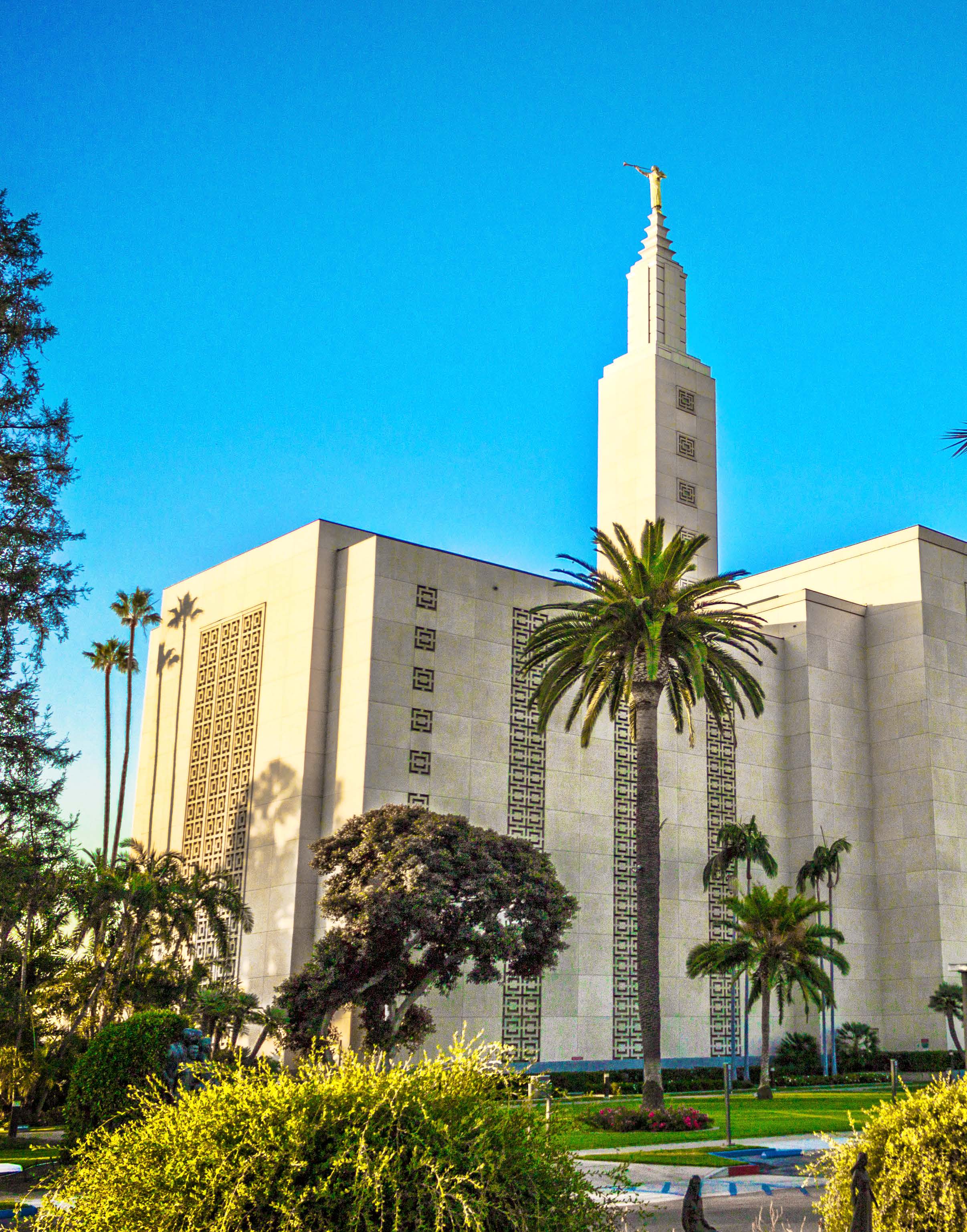
1957 Church produces film on Los Angeles Temple
1958 Temple grounds are cited as contribution to civic beauty
1961 Sculpture of family group is placed on temple grounds
1964 Branch family history library is established in visitors’ center basement
1966 Statue of the Christus is placed in visitors’ center lobby (November 21)
1967 Visitors’ center is rededicated after being substantially upgraded (June 3)
1980 Thirteen miniature statues of women are placed in sunken garden (August)
1985 Japanese television features Los Angeles Temple and Mormon concept of eternal marriage
2008 Hostile demonstrations follow passage of Proposition 8 defining marriage (November)
2015 Lawn is allowed to yellow to conserve water during severe drought
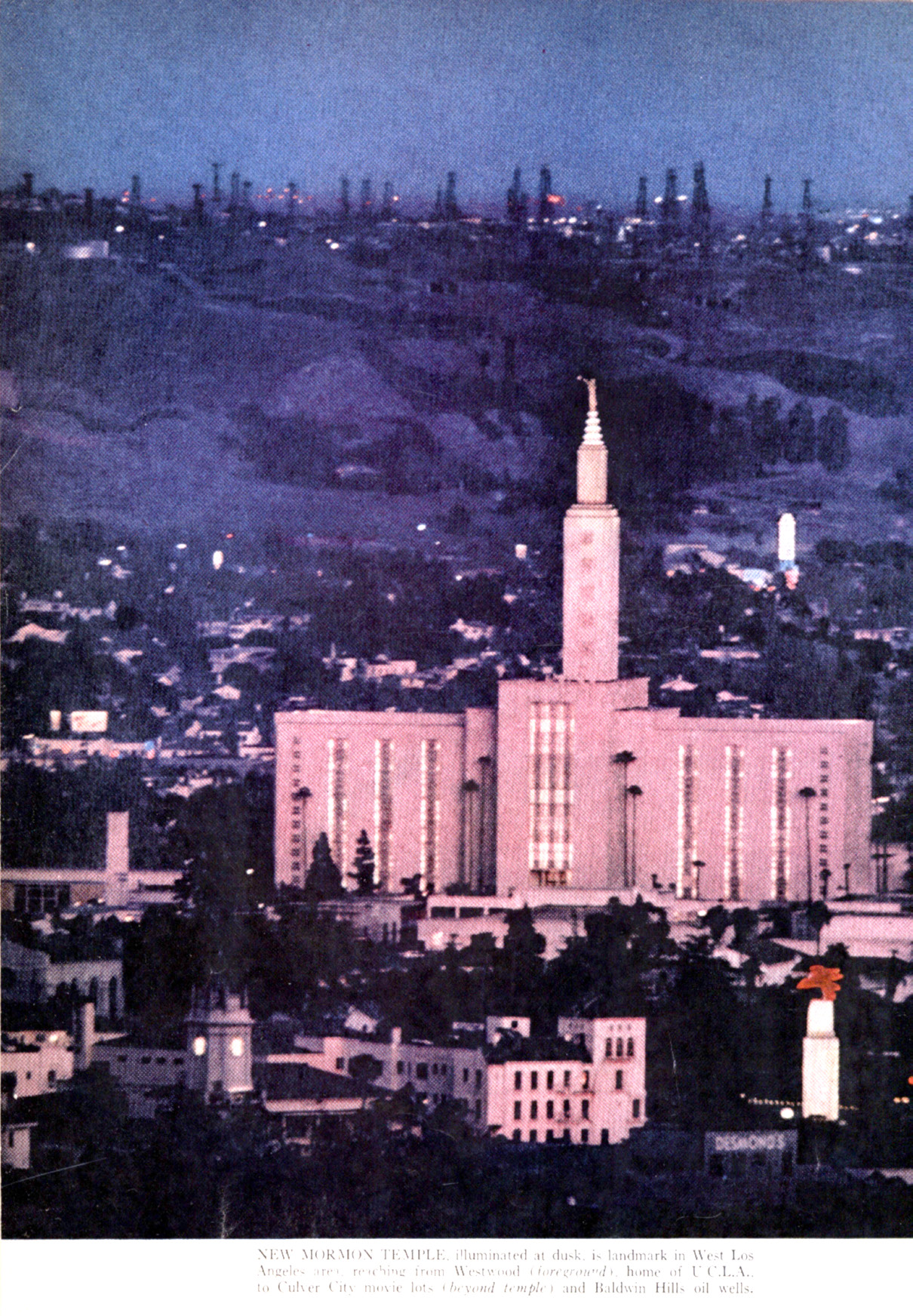
In 1981 President Spencer W. Kimball declared that the Church has a threefold mission: perfecting the Saints, proclaiming the gospel, and redeeming the dead.[1] This suggests that The Church of Jesus Christ of Latter-day Saints must relate to at least three groups of people: those who currently are members of the Church and need to be perfected, those living around us who are not members of the Church and to whom the gospel must be proclaimed, and those who died without the blessings of the gospel and who must be redeemed. Obviously the vicarious ordinances performed in the Los Angeles Temple are related to redeeming the dead. Performing this service in the temple also plays a key role in perfecting the Saints. These subjects were considered in the previous chapter. This present chapter will show that the other facilities at the temple site also relate to two of these three groups of people—building bridges to friends and neighbors who are not members of the Church, sharing the gospel message with them, and helping Latter-day Saints perfect their own faith as they share it with others. These facilities at the temple site include the temple grounds themselves and the visitors’ center, as well as special groups of sculpture.
The Temple as a Missionary
The beautiful temple building itself plays a key role as a missionary. The widespread attention and admiration generated by the open house continued after the temple was dedicated. For example, the July 15, 1957, issue of Time included a full-page colored photograph of the temple to help illustrate an article on growth in the city of Los Angeles.[2]
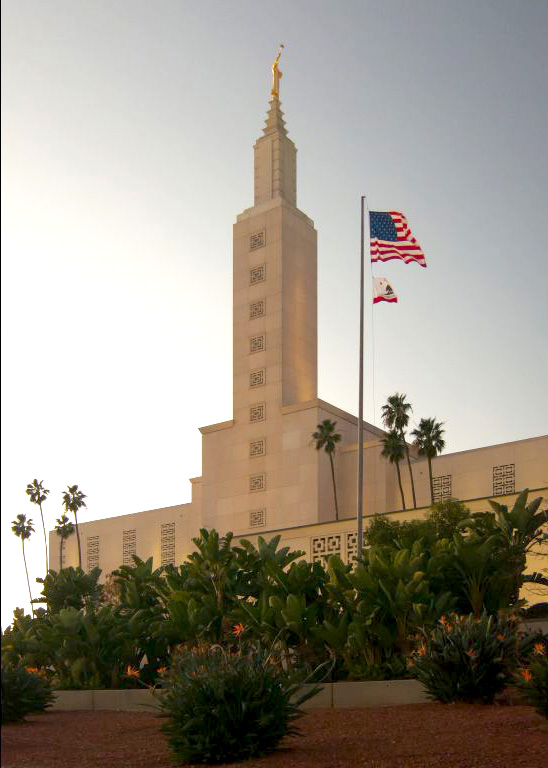
The Church also produced a half-hour motion picture featuring the Los Angeles Temple. It reviewed the history of construction, showed the temple’s “magnificent interior,” and explains the building’s functions. This color-and-sound film was produced by KSL-TV in Salt Lake City under assignment by the First Presidency. Filming of the temple’s interior began during the open house so had to be done at night. “Tons of lighting equipment and miles of electrical cable were hauled into the temple each night.” As a precaution, “hundreds of yards of muzzling” were spread out to protect the carpet and furnishings from being soiled. “A crew of some of the ablest lighting experts in the motion picture industry” aided with the filming of the large rooms. The presentation concluded with an explanation of the purpose of temples given by President David O. McKay, filmed in his office. This project took over a year to complete, and by early 1957 the film was being shown in the bureau of information, and copies were available for viewing by local Church units and other groups.[3]
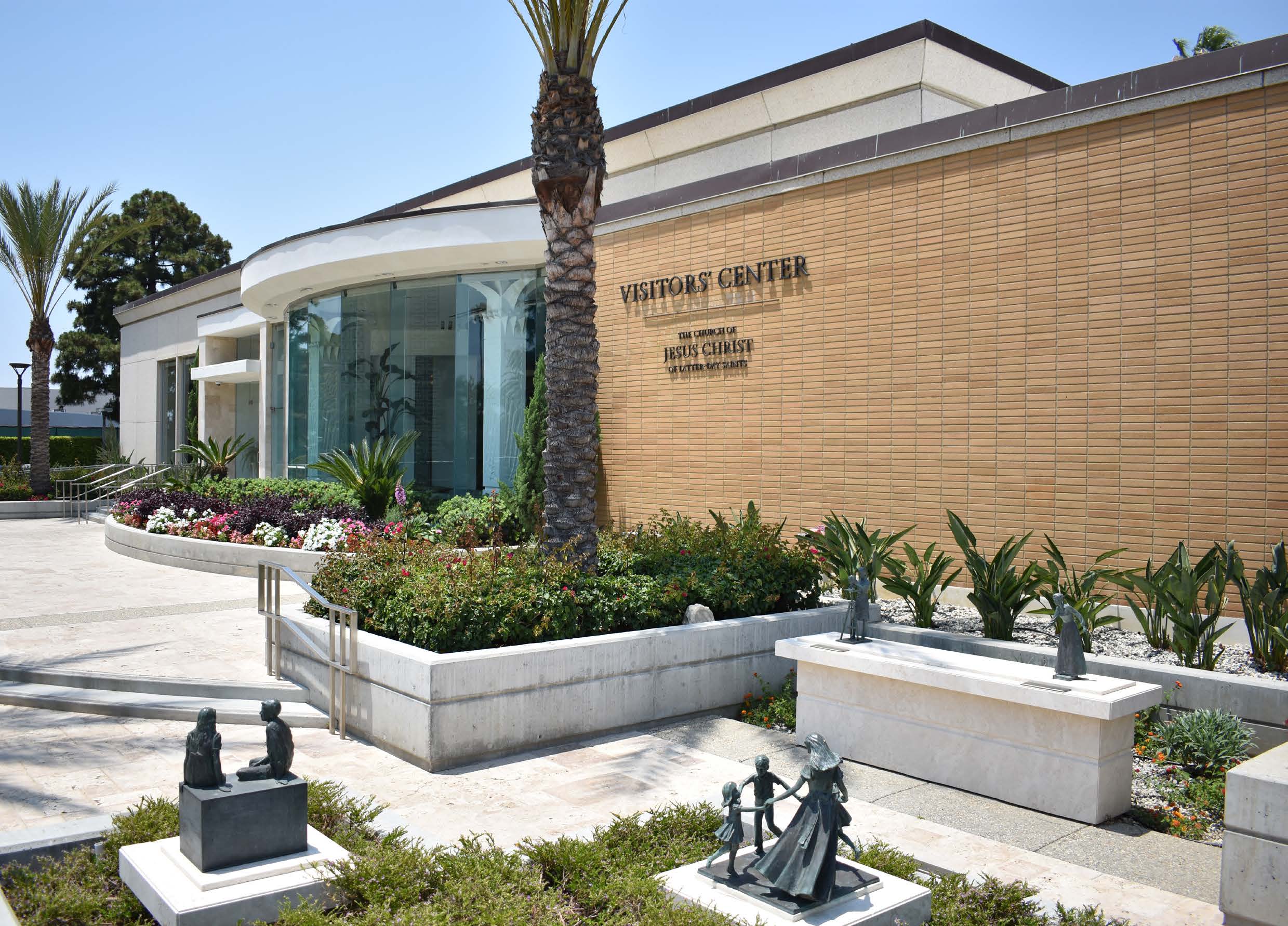 The visitors’ center, formerly the bureau of information. (Katie Hendrickson)
The visitors’ center, formerly the bureau of information. (Katie Hendrickson)
Interest in the temple spread even overseas. In the nation of Israel, the Haifa Art Museum and Technological Institute set up an exhibit on the Los Angeles Temple in 1957, using materials supplied by A. Merlin Steed at the bureau of information. It featured colored photographs and selected publications related to the temple. The Haifa display “aroused much interest in the local architectural circles as well as among the art-minded public.”[4]
The Temple Grounds
The beautiful grounds surrounding the temple also continued to receive favorable attention even after the open house and dedication were concluded. In October 1958 the temple was cited by a committee formed by the Los Angeles Chamber of Commerce “to promote civic beauty. The award described the temple’s architecture and landscaping as “an inspiring example to the community.”[5] Similar recognitions continued in later years.
The Church was also praised when it took steps even though they may have detracted from the appearance of Temple Hill (as the site had come to be affectionately called). For example, during the fall of 1973, when there was a widespread energy shortage, the Church curtailed the nighttime illumination of its temples, including Los Angeles. Then in 1984 the Church was commended for its conservation of water on the Los Angeles Temple grounds during a drought. During an even worse drought in 2015, California residents were asked to quit watering lawns altogether. The Church agreed to comply with this request, and the yellowing slope between the temple and Santa Monica Blvd. was a visible evidence of the Church’s desire to be a good citizen of the community.
In 1989 a tall flagpole was installed in front of the temple. Having the Stars and Stripes flying was a definite answer to those who were not acquainted with the Church and may have questioned whether or not it and its temple were really American institutions.
The Family History Center
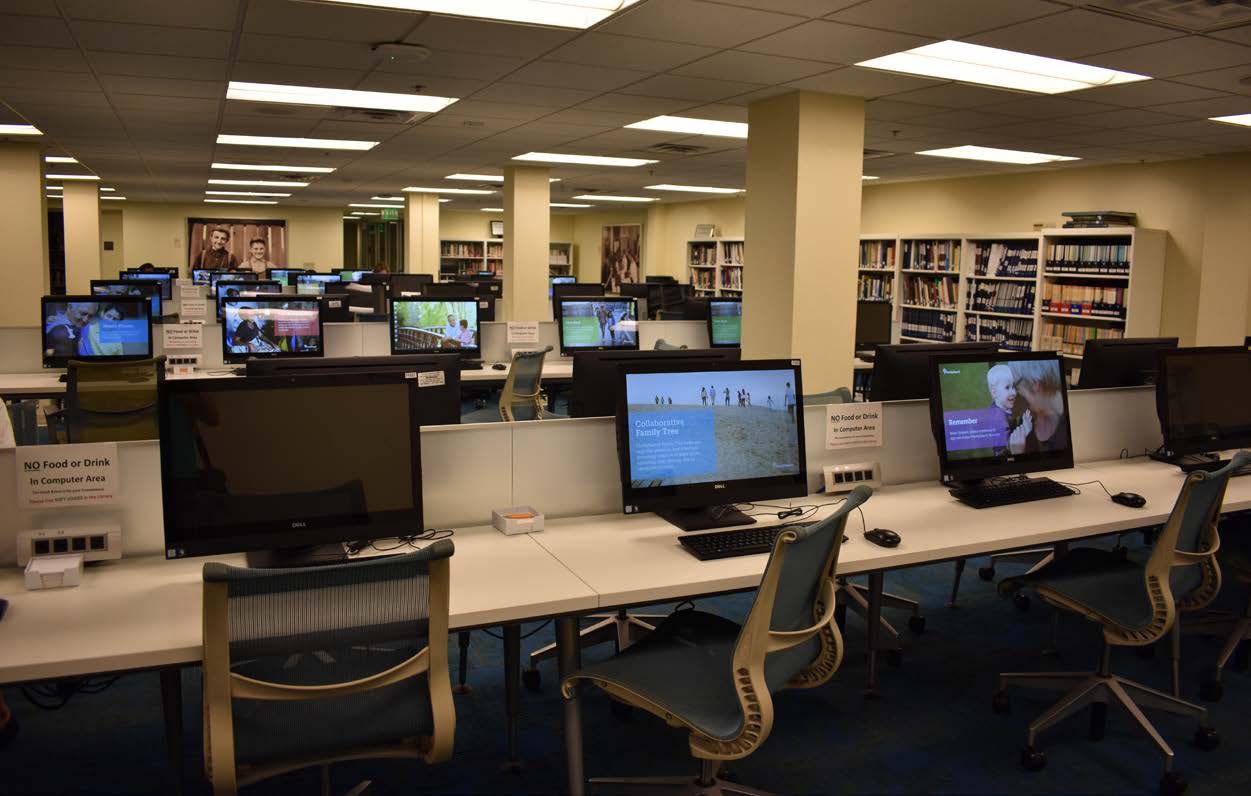
Genealogical or family history research is the means to identify those for whom temple ordinances are to be performed. Temple president Benjamin L. Bowring related his own family’s involvement in this work when he was invited to speak at the Church’s general conference in April 1959.[6] To assist Latter-day Saints in this endeavor, the Church established the Genealogical Society of Utah in 1894. Over the years, this society developed its library in Salt Lake City, commonly regarded as the premier family history resource in all the world. The advent of microfilms in the 1930s enabled the library to gather records from many nations.
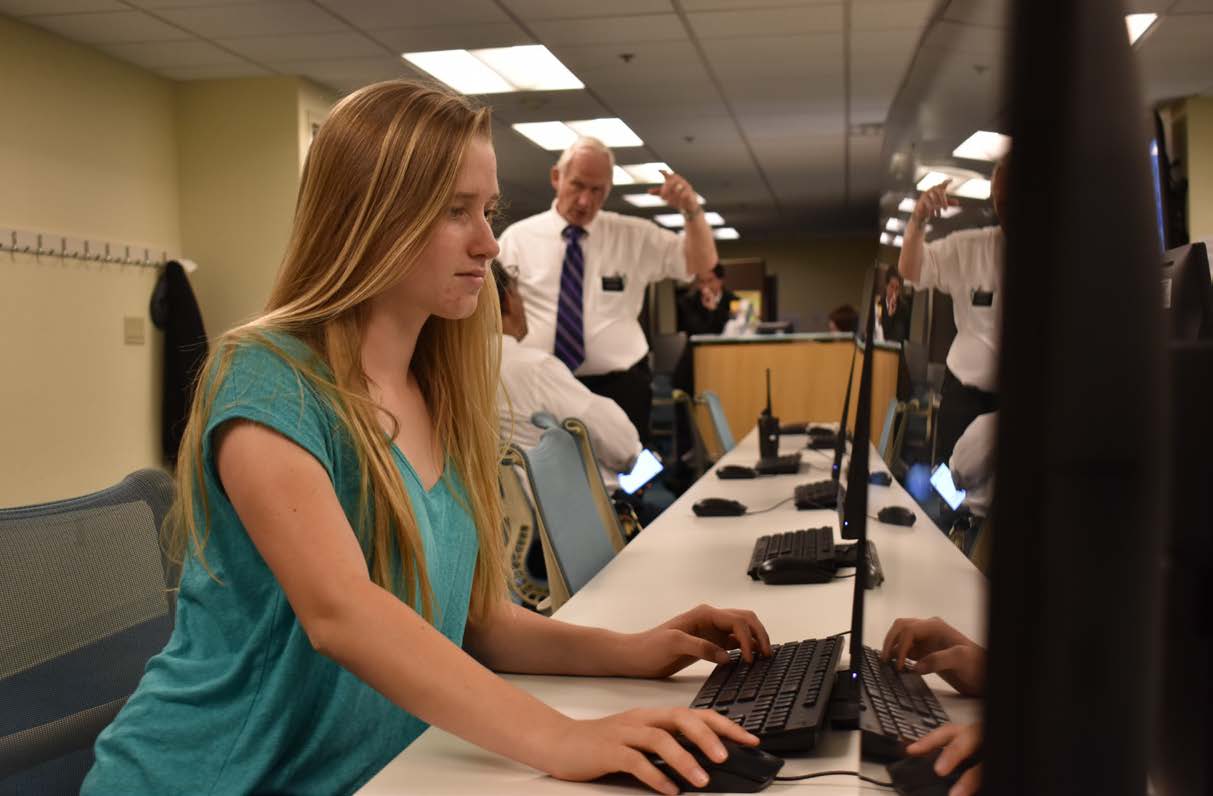 The Family History Center—Katie Hendrickson works on family history while a missionary assists another patron. (Courtesy of Katie Hendrickson)
The Family History Center—Katie Hendrickson works on family history while a missionary assists another patron. (Courtesy of Katie Hendrickson)
The use of microfilms also made the establishment of branch genealogy libraries practical. Microfilm copies of materials in the main library could be circulated inexpensively as needed in the branches, surpassing 4,500 worldwide in the early twenty-first century. The first of these opened in 1964, including the one in Los Angeles. It was dedicated on June 20 of that year at a meeting in the nearby Westwood Ward chapel by Elder Thomas S. Monson, at that time the newest member of the Quorum of the Twelve Apostles. The library was located in the basement of the bureau of information. E. Kay Kirkham became the first librarian; he had gained experience as a staff member at the National Archives in Washington, D.C., and at the Church’s genealogy library in Salt Lake City. An especially helpful resource at the branch library was a master index which included references to the 37,000 books and other items located in the genealogy section of the main Los Angeles public library downtown as well as indexes to several other noted family history collections throughout the country.[7]
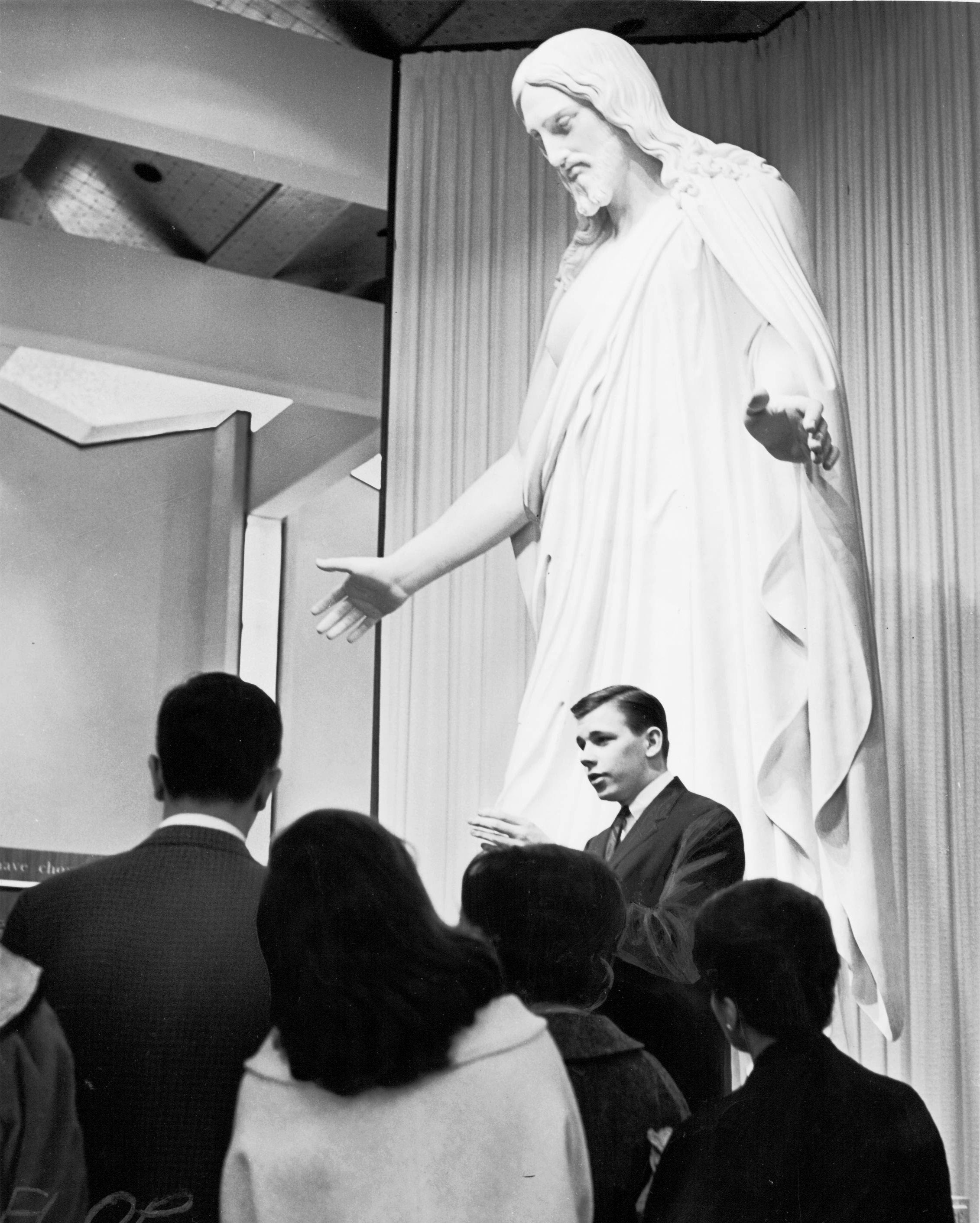 The Christus in the New York World’s Fair pavilion. (Courtesy of Matthew O. Richardson)
The Christus in the New York World’s Fair pavilion. (Courtesy of Matthew O. Richardson)
Wards and stakes in the temple area funded the library. The high priests quorum in the Los Angeles Stake, for example, raised $500 to buy comfortable library chairs to replace the hard folding-chairs then being used.[8] Some contributions came from unexpected places. A genealogy class of the Tokyo Branch in Japan, took an interest in the Los Angeles Temple library and raised their contribution through selling pearl tie pins. Such funding enabled the library to expand its collection over the years. A purchase in 1966, for example, gave the library a complete set of U.S. censuses from 1790 through 1860, with censuses from selected western States through the 1880 census.[9]
The Christus
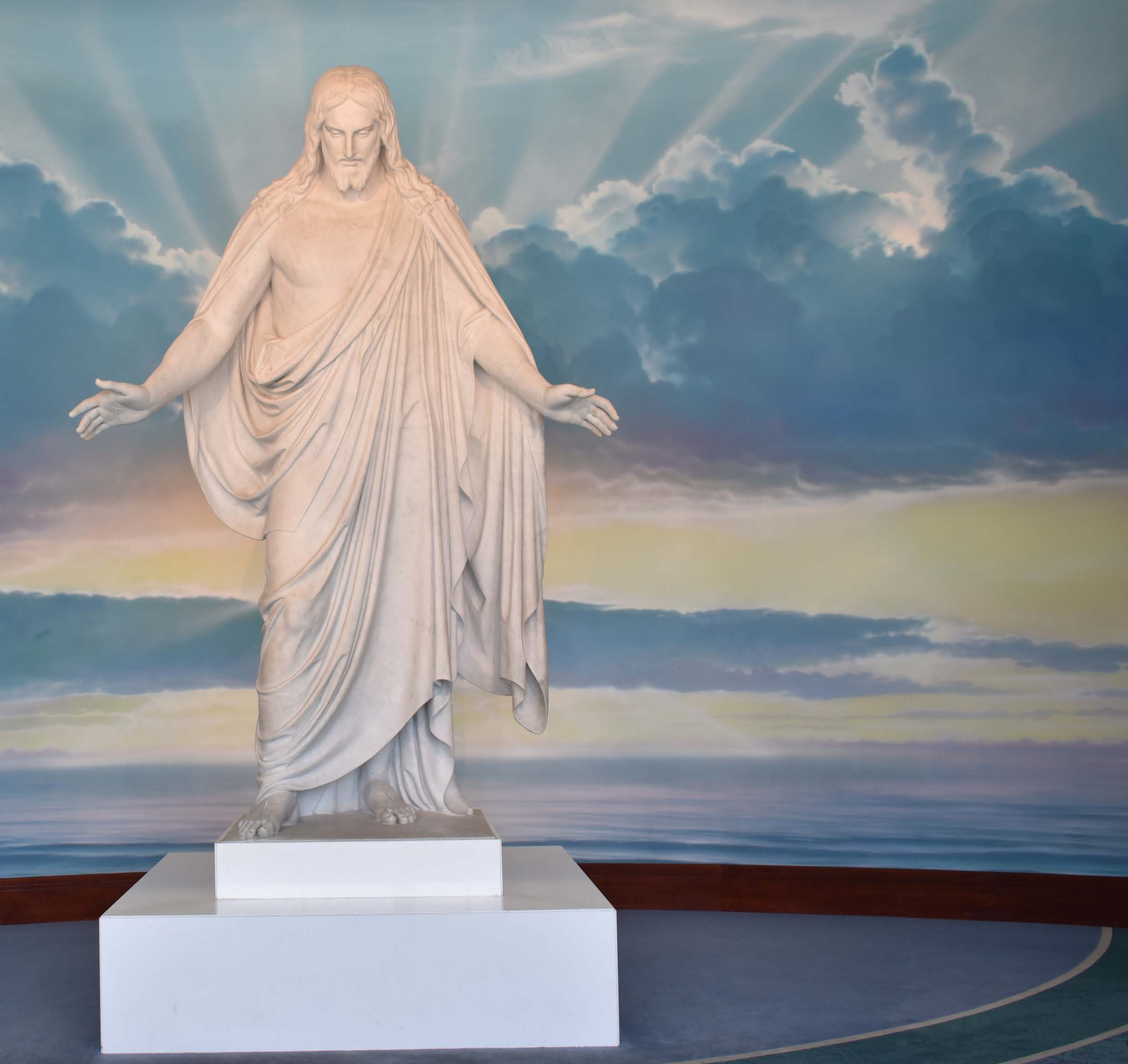
A Danish sculptor, Bertil Thorvaldsen, created his statue of Christ, the Redeemer in 1821. It became known as the Christus, and its outstretched hands represented the love and faith that inspires all men to come to the Savior. The original is in the Vor Frue Kirke (Church of our Lady) in Copenhagen. President Stephen L Richards, a counselor to David O. McKay in the First Presidency, saw a replica of this statue at Forest Lawn Memorial Park in Glendale during one of his visits to Southern California. He was impressed that a copy of this sculpture should be on Temple Square in Salt Lake City. During the 1950s, with the help of Hubert Eaton at Forest Lawn, he made arrangements to purchase a full-size marble replica of the eleven-foot statue as a gift to the Church. In 1965 it was placed in the new Visitors’ Center on Temple Square.
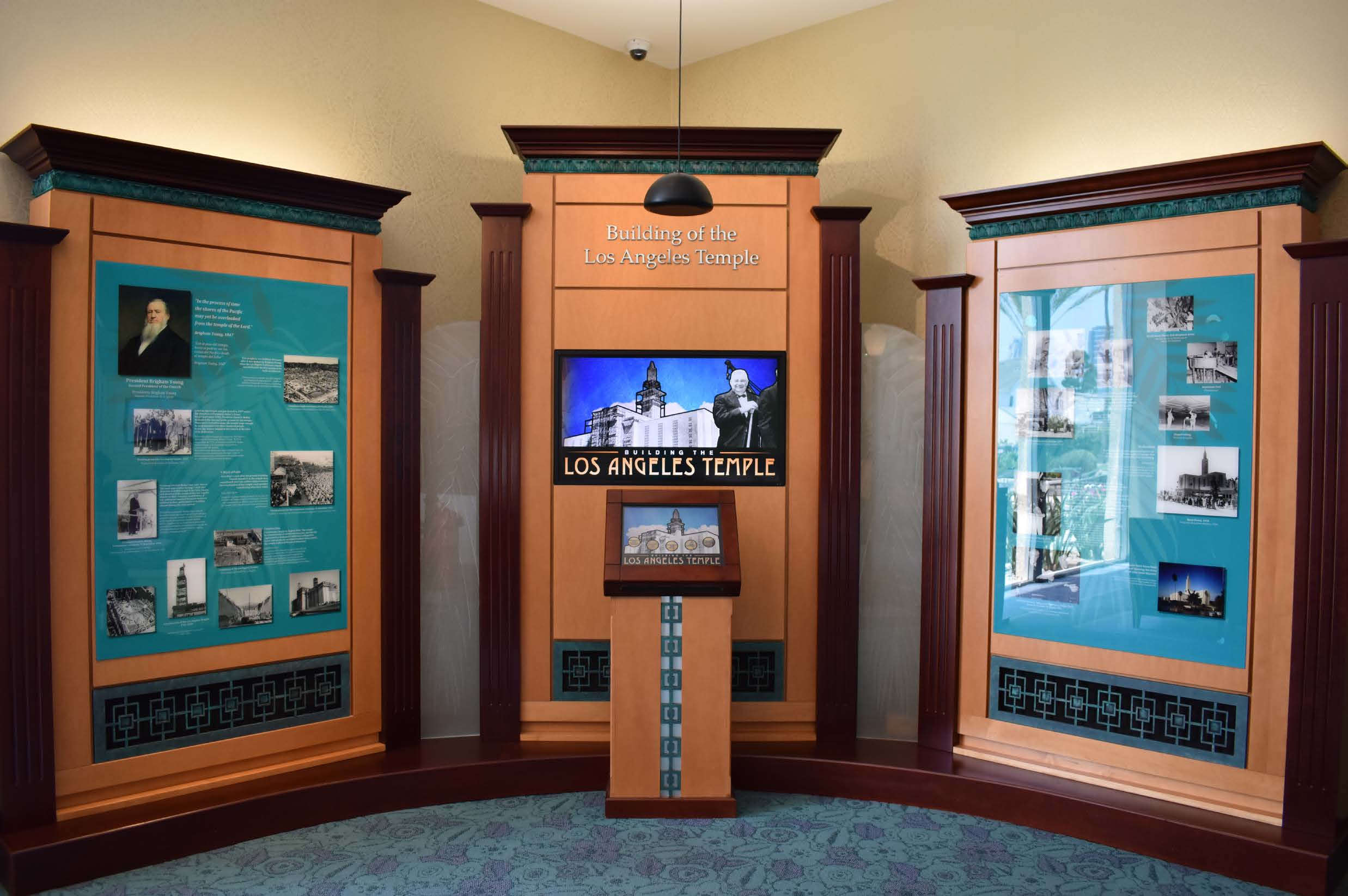 Los Angeles Visitors’ Center displays. (Katie Hendrickson)
Los Angeles Visitors’ Center displays. (Katie Hendrickson)
Meanwhile, the Church was invited to have a pavilion at the New York World’s Fair during 1964 and 1965. Eager to emphasize that Mormons truly are Christians, the Church purchased a second copy of the Christus for its pavilion. It became a central feature of the Latter-day Saint exhibit there and attracted widespread and overwhelmingly positive attention. After the fair closed, Church leaders considered moving the New York Christus to the visitors’ center at Joseph Smith’s birthplace in Vermont, but its eleven-foot height would not fit in the building there. They therefore decided to send it to Los Angeles to be used in the temple visitors’ center which was about to be substantially refurbished. The large sculpture was placed on a flatbed truck and covered with a tarp for the cross-country trip. “Upon its arrival in Los Angeles, the statue was chipped in spots, oil-stained, dirty, and had two broken fingers.”
The Christus was put into storage until the visitors’ center was ready to receive it. The floor had to be strengthened with eight tons of concrete to support the six-ton weight of the sculpture. On November 21, 1966, the statue was moved into the bureau’s foyer. “A gantry crane was used to lift and roll the statue through the doorway. This required careful maneuvering because the arm span of the Christus was wider than the opening in the building.” After the sculpture was fastened to floor with brass dowels, “a young, local artist repaired the chips and fingers and then cleaned the statue with acids and steel wool.”[10] A thirty-foot “floating-panel mural” of the firmament, painted by Los Angeles artist Ken Hodges, provided a fitting and impressive background.[11] The sculpture and mural were intended to emphasize the key Latter-day Saint teachings that “Christ both is the Savior of the world and the Creator of the universe.” Other replicas of the statue have subsequently been placed in visitors’ centers around the world, and the Christus has become an image readily identified with the Latter-day Saints.
The Bureau of Information
The impact of the New York World’s Fair pavilion on the Los Angeles Temple Bureau of Information was not limited to the statue of the Christus. The bureau’s roots go back to the beginning of the twentieth century when the Church had new opportunities to share its message with travelers who increasingly stopped in Salt Lake City. In 1902 the Church opened a bureau of information on Temple Square to make visitors feel welcome, conduct tours, and provide literature. The success of this venture led to new bureaus at several Church history sites being patterned after the one on Temple Square.
When the Church accepted the invitation to have a pavilion at the New York World’s Fair in 1964 and 1965, a great deal of effort went into planning it. Displays were developed to present the message of the restored gospel most effectively. These included murals, original paintings, statuary, dioramas, carousels, and other interactive features. A motion picture, Man’s Search for Happiness, depicted life’s experiences from birth to death and placed them in the broader context of an existence before mortality and life beyond the grave. The eleven-foot sculpture of the Christus with outstretched arms left no doubt that Mormons are Christians. The success of this pavilion prompted the Church to reevaluate the role of its bureaus of information at historic sites across the country. Rather than merely providing facts about events at the particular site, these bureaus could become effective means of sharing the gospel. They were extensively remodeled and received displays similar to those which had been so effective at the New York pavilion. All this was done under the direction of the Church Information Committee, chaired by Elder Mark E. Petersen and assisted by Elders Richard L. Evans and Gordon B. Hinckley, all of the Twelve. Church leaders believed members should have “Church history stories come alive with new interest and intensity,” while the general tourist would receive “a fresh new look at Mormonism.”[12]
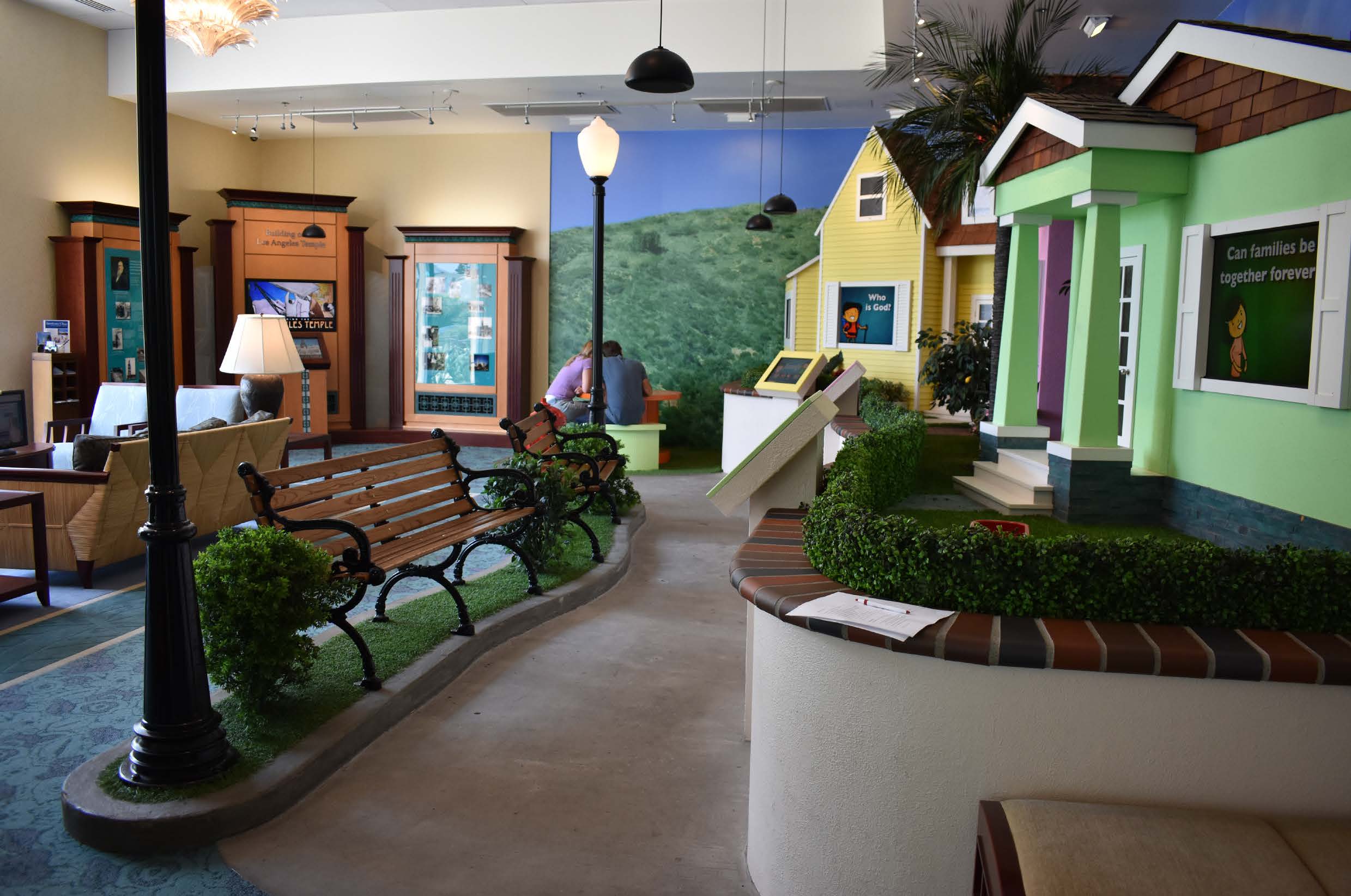
During its first decade, the bureau of information at the Los Angeles Temple had exhibited copies of the Book of Mormon paintings by Arnold Friberg, together with small replicas of the temple’s baptismal font and statue of the angel Moroni. In 1967, however, the Church announced that this bureau would be completely transformed in light of the experience in New York. It “will be one of the most elaborate of the score or more to be [re]opened by the Church this season for tourists and other visitors” and will be regarded as “one of the major bureaus of information.” The magnificent statue of the Christus backed by the mural of the firmament would completely dominate the central foyer. The plan was for missionary guides to take visitors into the west wing where they would see eight paintings of Christ by the noted Danish painter Carl Bloch, further emphasizing Latter-day Saints’ faith in the Savior. Three of these would be “translites” (backlighted transparent images). The Reformers’ panel would next feature Paul’s prophecy of a “falling away” (2 Thesssalonians 2:3), corroborated by statements by Martin Luther, John Wesley, and Roger Williams, as well as the Apostle Peter’s reference to a latter-day “restitution of all things” (Acts 3:20–21). A set of statues depicted Moroni as a mortal man preparing the Book of Mormon record on metal plates and then as a resurrected being giving the plates to the young prophet Joseph Smith. Four translites featured the appearance of the Father and the Son in the First Vision, Joseph Smith translating the plates, and the latter-day restoration of the priesthood. The bureau’s north wing contained a twin diorama showing Christ in the Old World declaring that He had “other sheep . . . which are not of this fold” as recorded in the Bible (John 10:16) and then the Book of Mormon’s record of his telling listeners in the New World that “ye are they” of whom he spoke when he referred to his “other sheep” (3 Nephi 15:21). An array of illustrations documented the variety of activities the Church offers its members in nations around the world. The east wing was converted into a theater where missionary guides gave a brief lecture, using visual aids to explain the purpose of temples, ancient and modern, focusing on work for the dead, baptisms, the endowment, and sealing of families. Included were pictures of the murals in the Los Angeles Temple. To climax their experience, visitors saw the moving film Man’s Search for Happiness.[13]
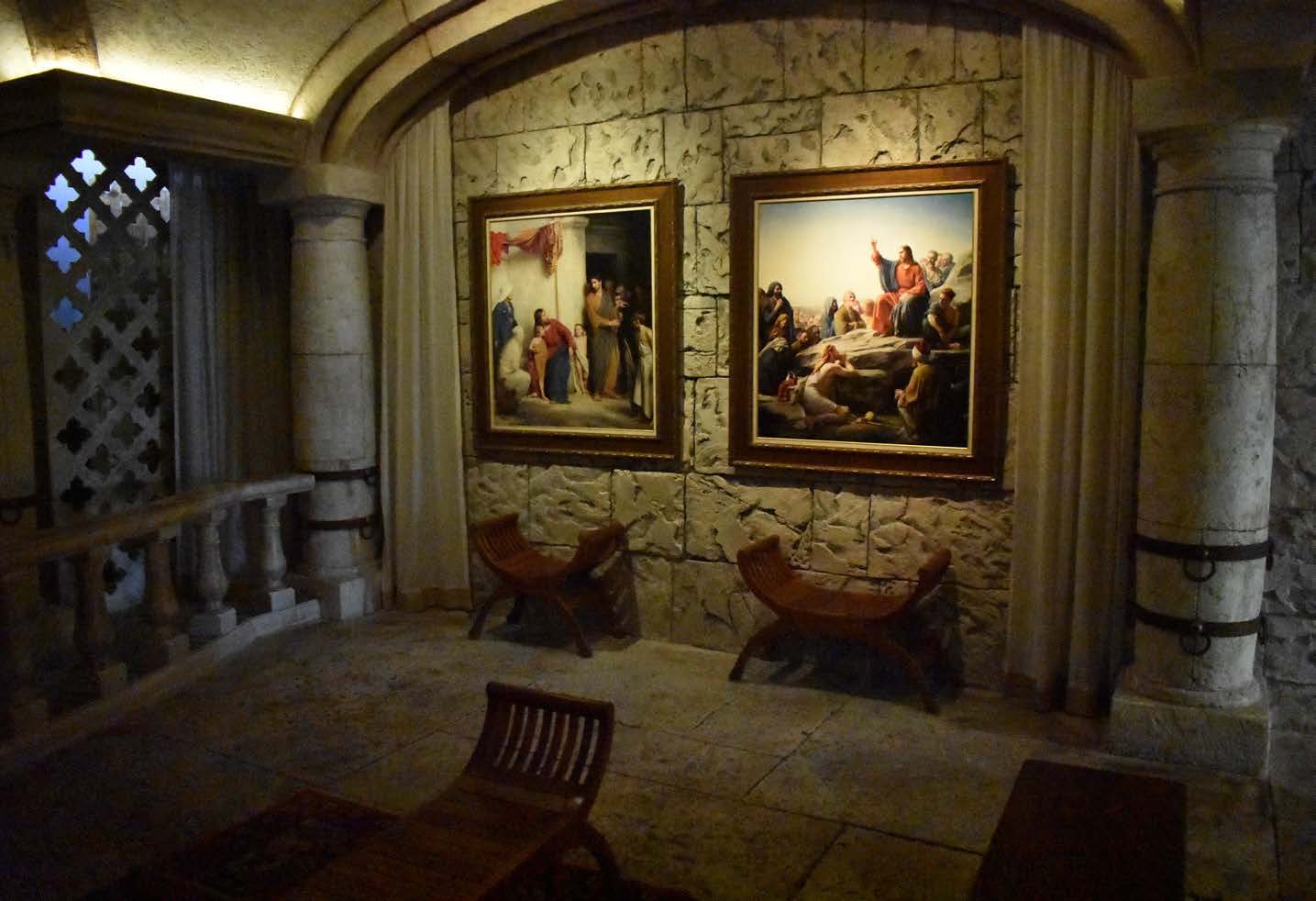
Now officially known as a visitors’ center, this facility “in terms of size and elaborateness was second only to the new visitors’ center on Temple Square in Salt Lake City.” It was rededicated on June 30, 1967. A special meeting convened in the Los Angeles Temple’s large third-floor assembly room for stake presidencies, stake mission presidencies, and the three full-time mission presidencies in the temple district. Elder Mark E. Petersen explained that “we are living in an age of visual aids” and that “we can teach better with them than we can without them.” He noted that the Church’s visitors’ centers were now designed to be teaching aids, so urged the Saints and missionaries to bring investigators and less-active members to the center. Elders LeGrand Richards, Gordon B. Hinckley, and Thomas S. Monson also spoke. They noted that the Los Angeles Temple Visitors’ Center provided an advantage that missionaries in most other parts of the world did not enjoy. At the conclusion of the meeting, Elder LeGrand Richards, who thirty years earlier had presided over the stake where the new center was located, offered the prayer of dedication.[14]

Jay A. Quealy, the recently appointed director of the new center, recruited several hundred guides, mostly returned missionaries, to serve there. A subsequent director, Don H. Smith, acknowledged that “many of the people who tour the center may never again come in contact with the Church unless we somehow touch them with our message of the restoration.” He continued: “That is why prayer is so important here. It is a must that we have the Spirit of the Lord with us.”[15]
An Interest in the Family
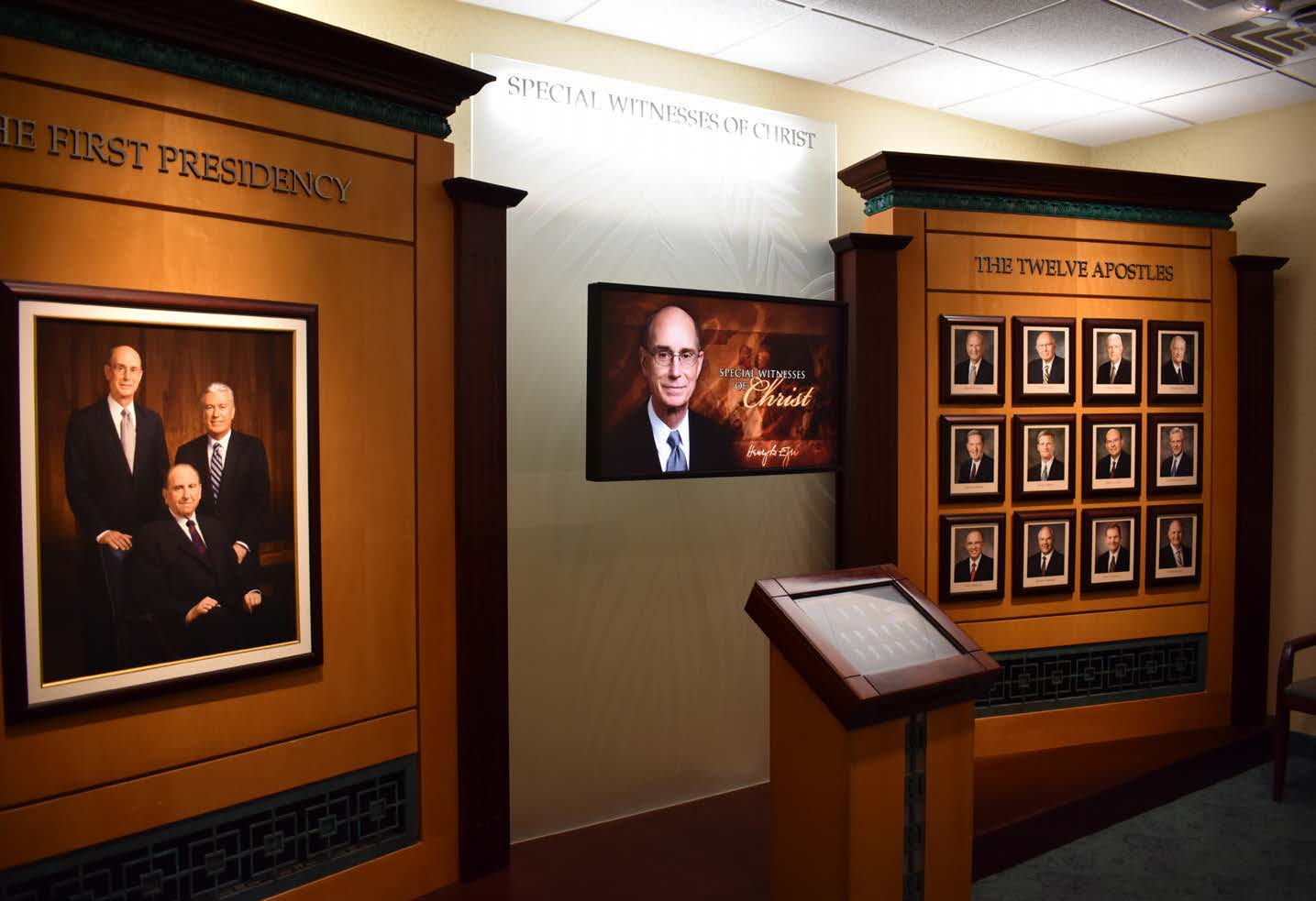
The creation of eternal families is a prime function of the highest ordinances performed in the temple. To focus on this topic, Church leaders commissioned Millard F. Malin to produce a heroic-size sculpture of a family group to be placed on the grounds of the Los Angeles Temple. He was the same artist who had sculpted the angel Moroni statue atop the temple’s tower. At first he “had many misgivings about undertaking the project,” but then realized the family was “the greatest of all subjects” and that family ties were “the chief motivation for temple work.” Hence this sculpture would be eminently fitting for the temple grounds. Malin began work on this new project in November 1956, the same year the temple was dedicated. He used two tons of clay to create the seven figures in the group, the tallest reaching 8 feet 8 inches above the base. The family group was cast in bronze using the lost-wax method in which the melted wax is drained off as the molten metal is poured into the casting. This was done at the Roman Bronze Works in New York, the same place where the 15-foot statue of Moroni and the oxen for the baptismal font were cast a few years earlier.[16]
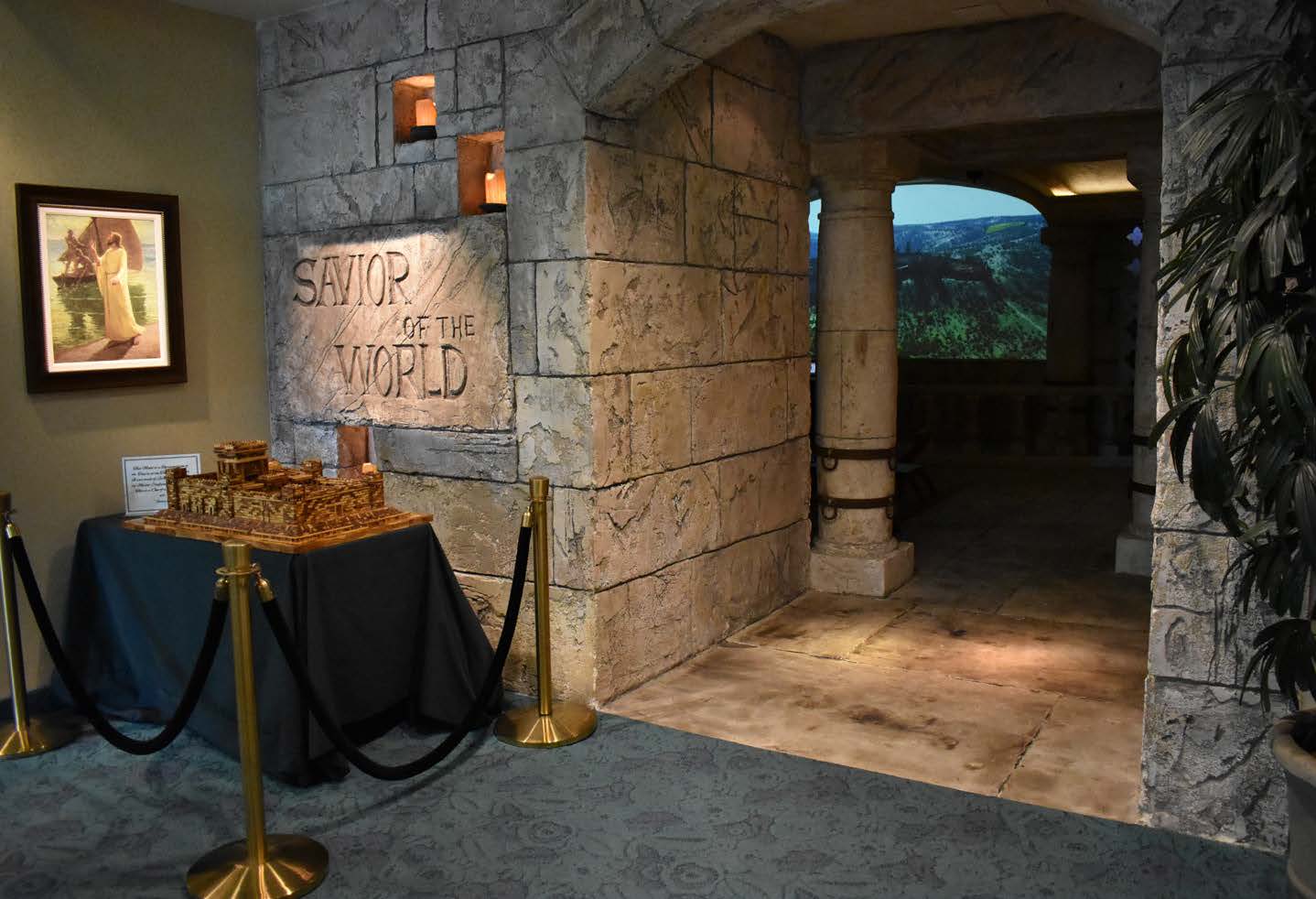
In 1961 the family sculpture was placed facing the temple across the reflecting pond from the building’s main entrance. In 1972, however, it was moved to a new location across the street from the visitors’ center where it gained greater visibility, especially for guests of other faiths who were coming to see exhibits in the center.
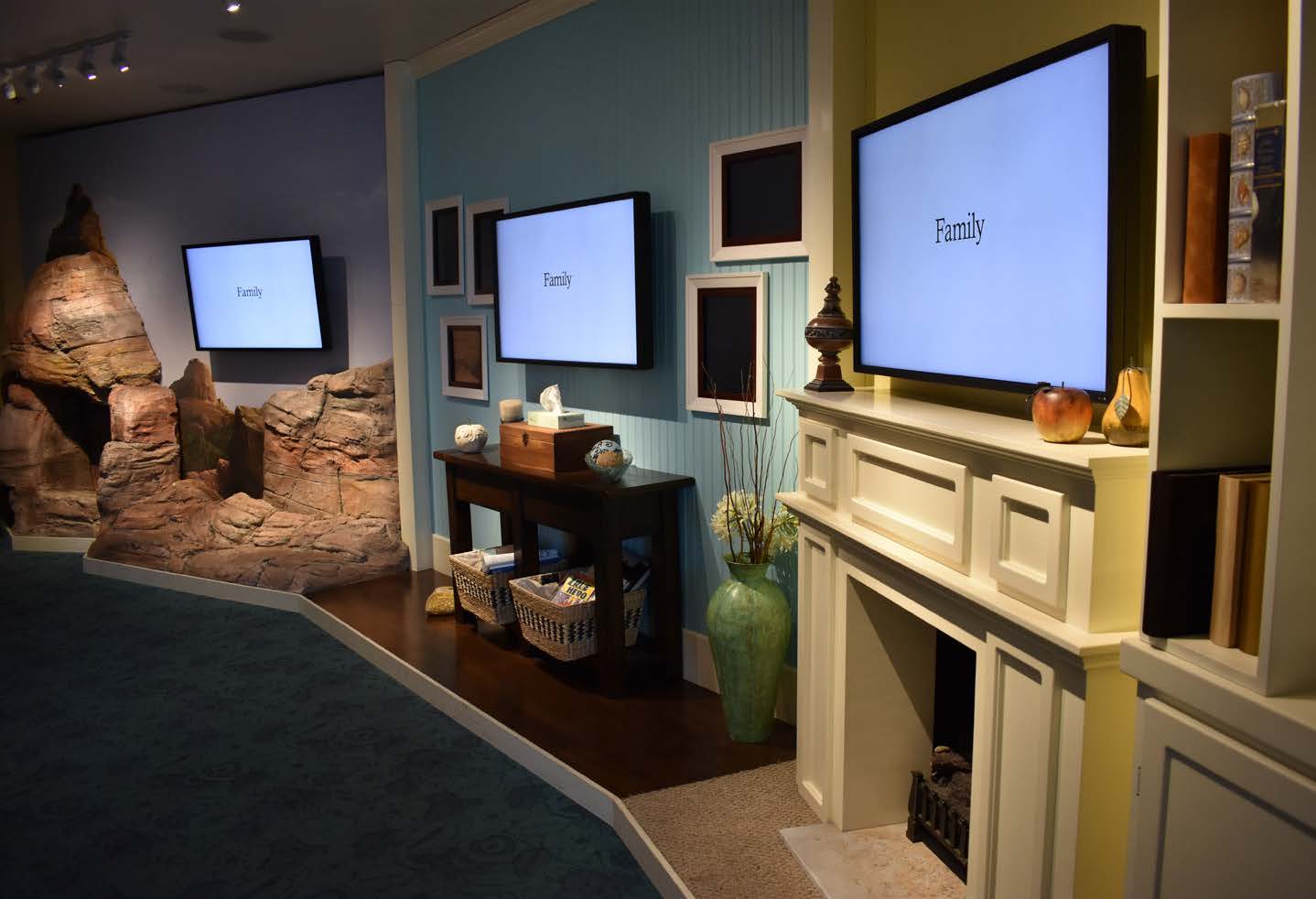
Latter-day Saint emphasis on the family gained attention even on Japanese national television. In 1985 an hour-long prime-time program on marriage and the family contrasted a traditional Shinto wedding in Japan with a Catholic ceremony in Brazil and a Mormon marriage in America. They wanted to include the Latter-day Saint wedding because the Mormon Church was well known in Japan and had a more “traditional approach to marriage.” The producers believed that the Church’s “attitudes about marriage are much the same as our own traditional Japanese ones.” With the help of the Church’s public affairs department, the Japanese producers arranged to interview three couples as they emerged from the Los Angeles Temple following their marriage. They were asked about what marriage meant to them. Ryan McDougle, one of the new grooms, responded, “Marriage in this beautiful temple means that our marriage will extend beyond this life and into eternity.” The interviewer was impressed with the Latter-day Saint young people he met. “They were beautiful. They are so fresh and clean. It is difficult to find such fine young people today. Their ideals and life attitudes are so honest.” The interviewer was also impressed with what he heard about “the simplicity of the wedding celebration,” which was the focus “rather than ‘a lot of materialistic display,’” conceding that the Japanese spend more on weddings than most other people. Jack McEwan of the temple presidency affirmed: “It was impressive to hear those newlyweds express their belief in the eternal nature of the wedding vows. I feel the expression of their beliefs will come through on TV.”[17]
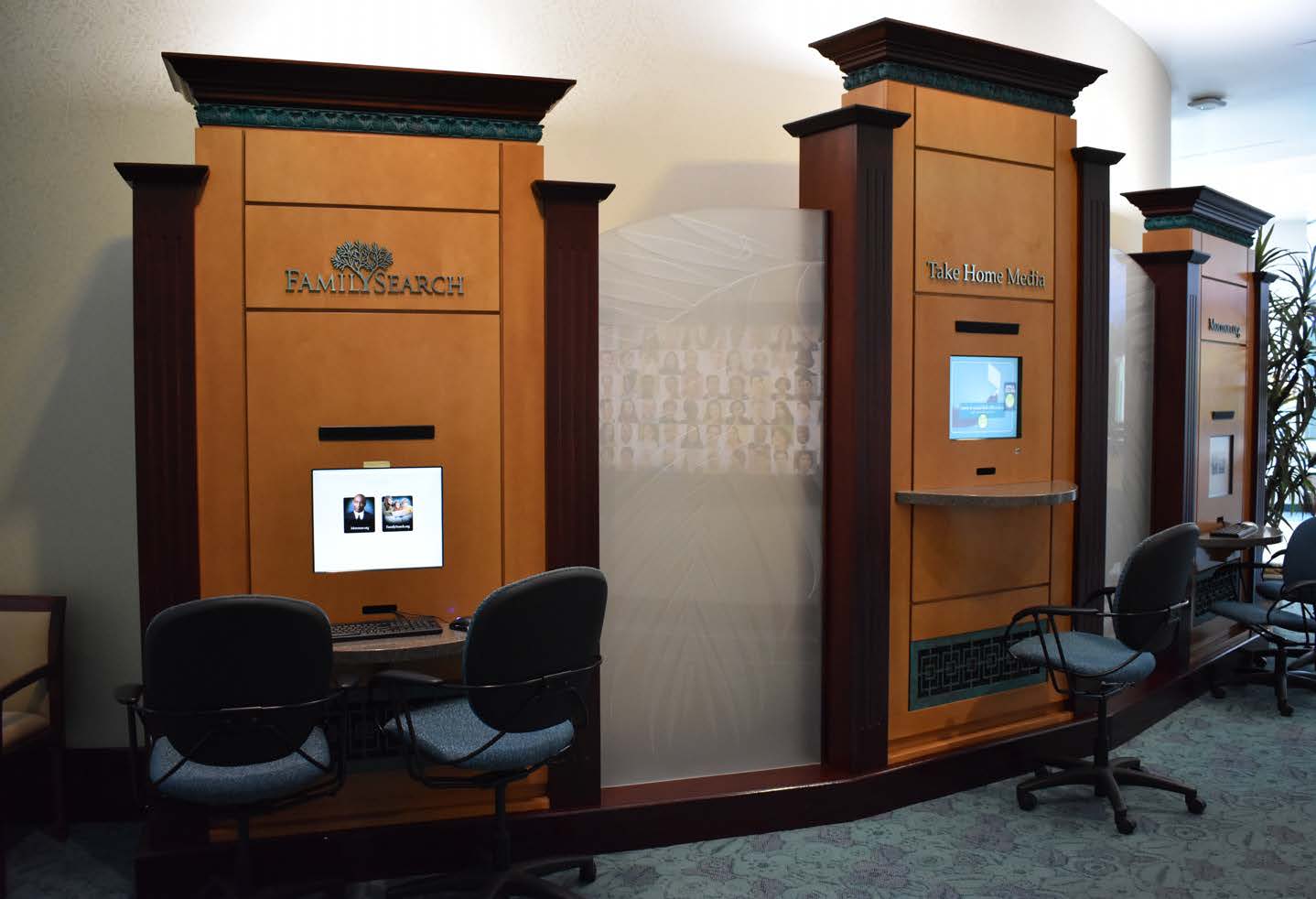
Another segment for Japanese TV focused more on the family. Todd Christensen, ward clerk in the Corona First Ward and member of the Los Angeles Raiders professional football team, was interviewed about his role as a father. The interviewers were impressed with the extent of his involvement with his children: “The Japanese father is not involved with his family like his American counterpart.” They were sure that “the Japanese will be surprised” to see how much he helps them in the home. They also interviewed ten-year-old Eric Poole as a representative Latter-day Saint school boy. He was one of six children in the family of Dennis Poole, bishop of the Yorba Linda Second Ward. They followed him through a “typical day,” including planning a backpack trip with his family. The producers were impressed with “the closeness and supportive attitude” in this Latter-day Saint family.[18]
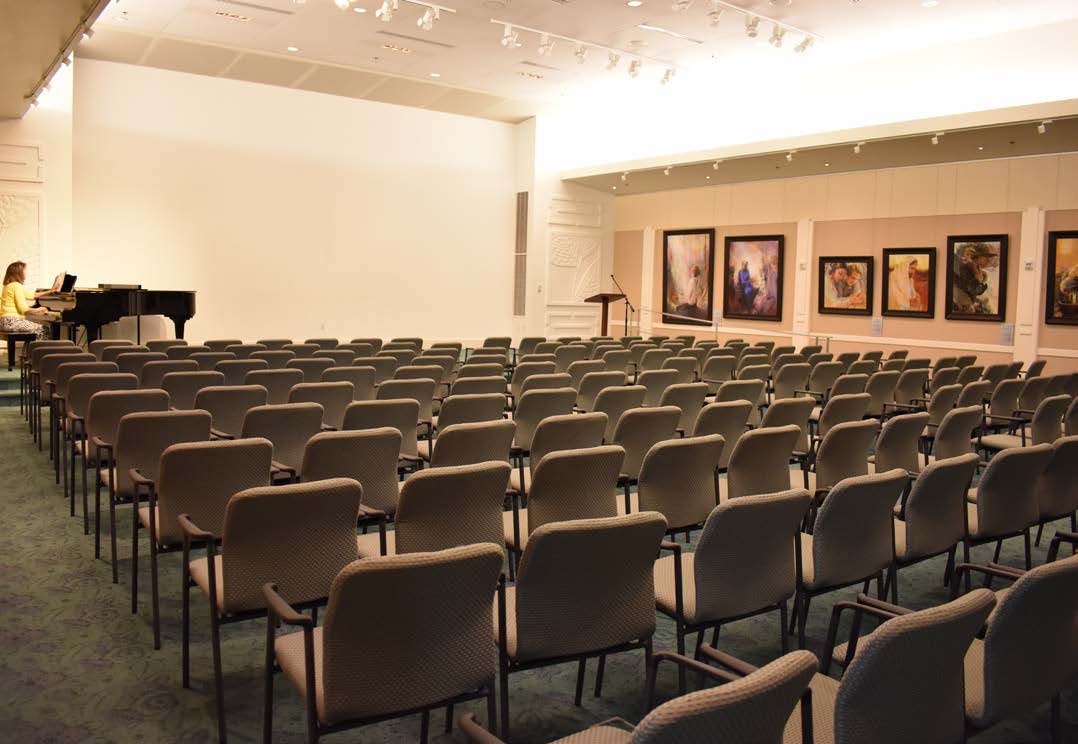
The Women’s Sculpture Garden
Women play a key role in the gospel plan and in The Church of Jesus Christ of Latter-day Saints. In 1978 thirteen life-size statues depicting women in varying roles were placed in a garden next to the visitors’ center in Nauvoo, Illinois. This Mormon Monument to Women is perhaps the largest sculptural group in the world dedicated uniquely to women. Sculpted by Dennis Smith and Florence P. Hansen, titles of individual statues include: Woman, Woman in Prayer, Woman Learning, Compassionate Woman, Preparing Her Son, Joyful Movement, In the Family Circle, In Her Mother’s Footsteps, Woman and Her Talents, Courtship for Eternity, Fulfillment, Teaching with Love, and Joseph and Emma Smith. In 1979 young women and young adult Relief Society members in the greater Los Angeles area presented 20-inch bronze replicas of these sculptures as a gift to the temple visitors’ center.[19]
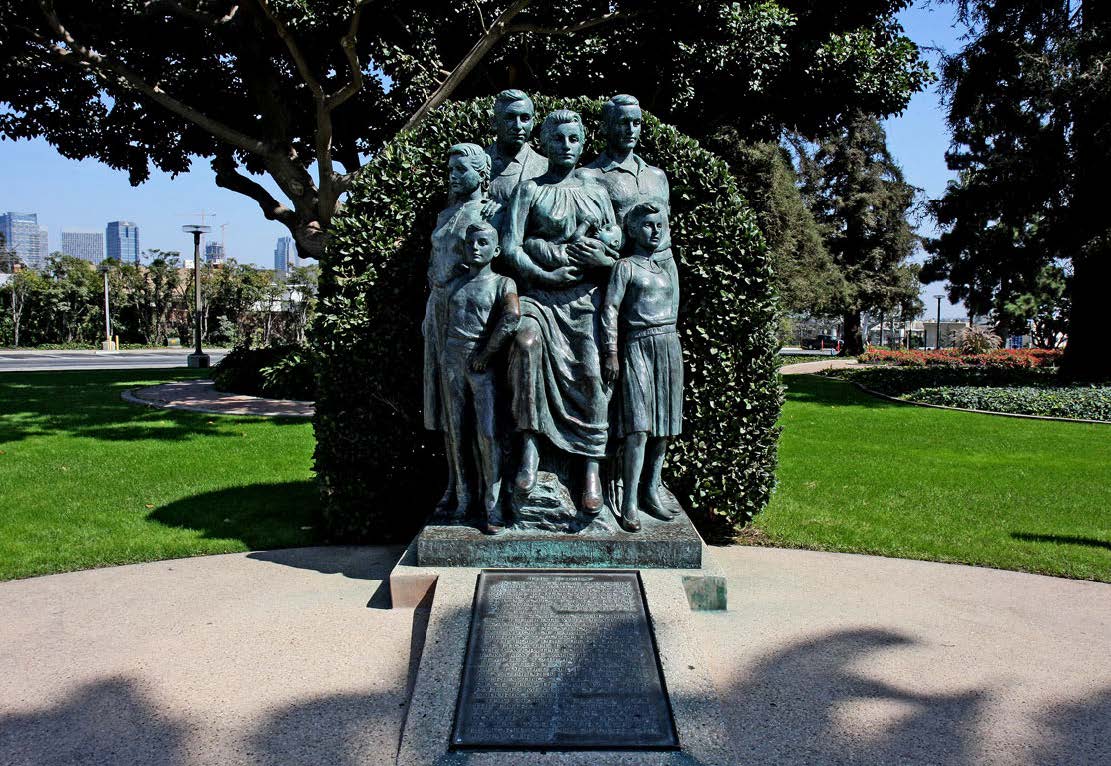
The statues had a premiere unveiling on three evenings, August 23, 24, and 25, 1979. Approximately twelve thousand Church members and other guests attended the evening programs held on the grounds in front of the visitors’ center. Ezra Taft Benson, President of the Quorum of the Twelve, was present and addressed the crowd on the exalted and essential role of women. Elder Mark E. Petersen of the Twelve, Young Women General President Elaine Cannon, Shirley Thomas of the Relief Society General Presidency, Relief Society General President Barbara B. Smith, and Flora Amussen Benson (President Benson’s wife) also were present and spoke. Elder S. Dilworth Young, an emeritus member of the Seventy and director of the visitors’ center, wrote the script for an audiovisual program introducing the statues. The program was narrated by Laraine Day, an LDS motion-picture star, and television personalities Heather Young and Mel Marshall.[20] Elder Young declared: “Every woman looking at them would see herself stepping confidently into the future with her head held high. She would know ‘that within her is the capacity for eternal progression, the strength to meet whatever situation life has to offer, and the right to choose the direction of her life.’”[21]
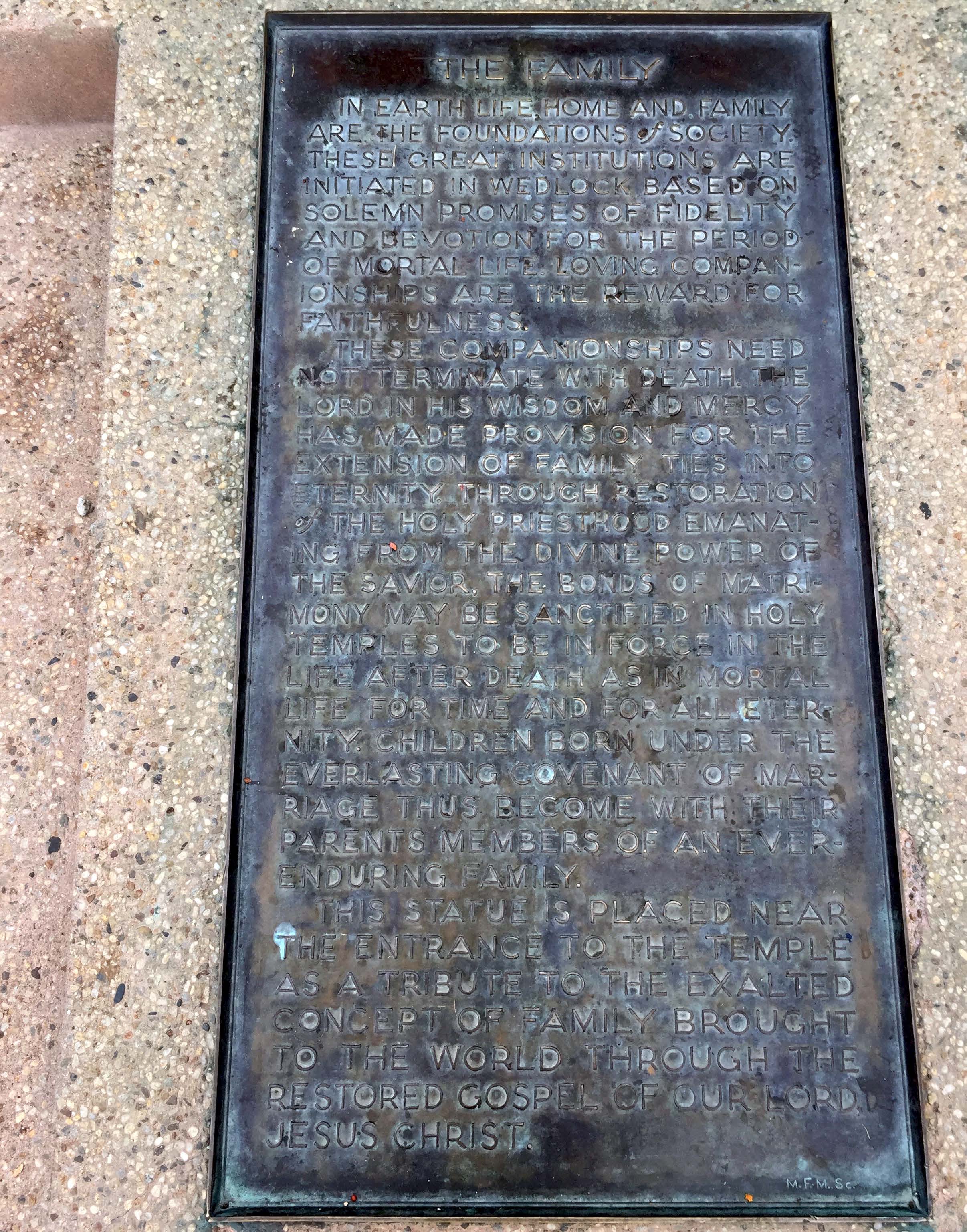
The following year these miniature statues were placed in a new sunken garden adjacent to the visitor’s center. This garden was dedicated on two evenings, August 23 and 24, 1980, by Elder Vaughn J. Featherstone of the First Quorum of the Seventy. Three thousand Church members and friends attended the ceremonies Friday evening, and more than six thousand were present Saturday evening. On both evenings the program, written by S. Dilworth Young, featured living tableaus illustrating the thirteen roles of women depicted by the statues; women from various cultures participated, representing the worldwide nature of the Church. One hundred young women, ages twelve and thirteen, marched in carrying handmade banners, measuring two by five feet, depicting a theme related to the family and the impact of the Church in their lives. A hand-rubbed walnut trunk filled with items from the sixty-five Los Angeles area stakes was sealed, to be opened in 2030 on the occasion of the Church’s bicentennial.[22]
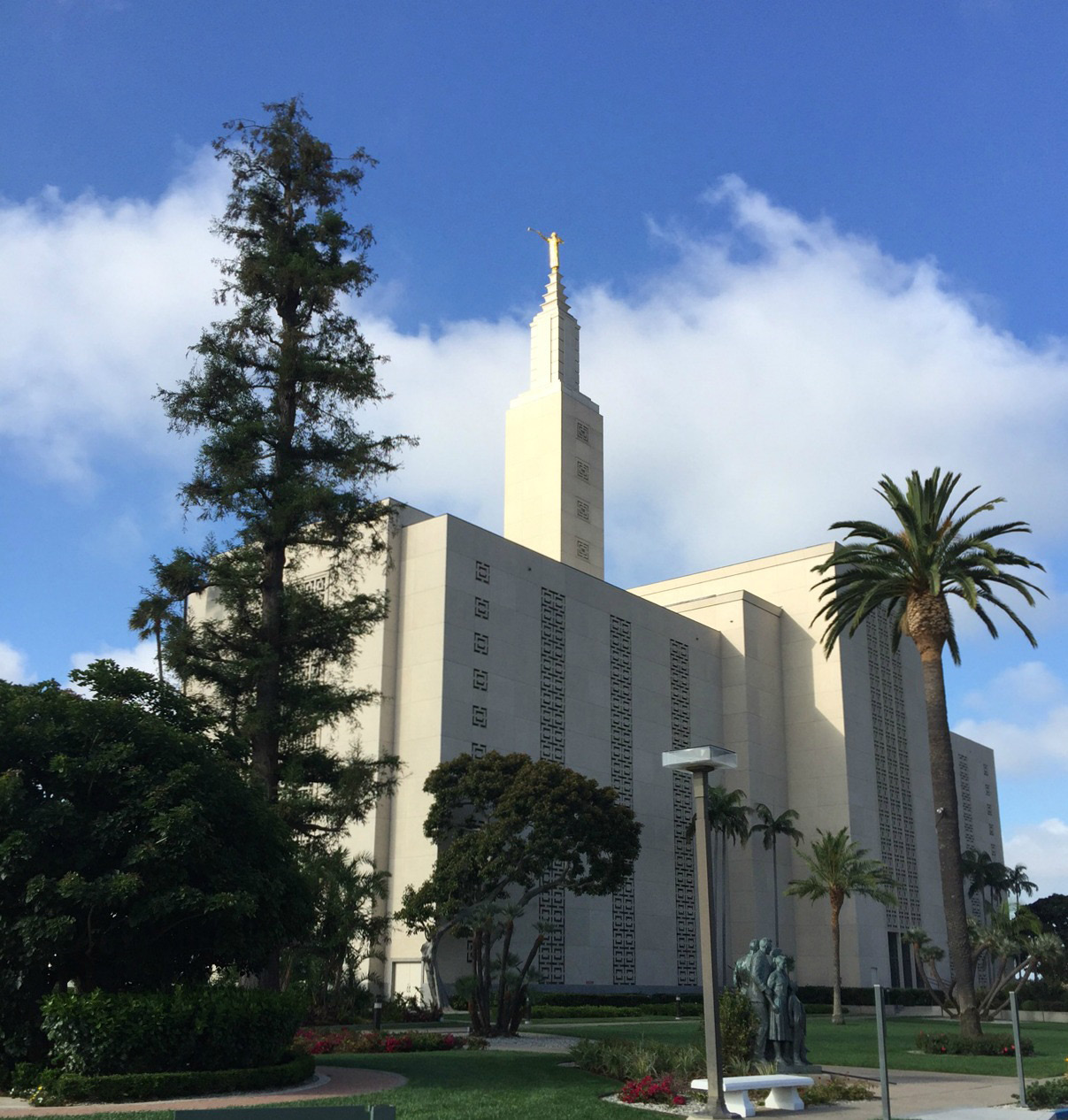
The Latter-day Saint concept of women was featured in a twenty-minute television segment broadcast in June 1981 on KNBC-TV, one of Los Angeles’s most prominent channels. With an estimated audience of about one hundred thousand , the program presented film clips provided by the Church plus materials supplied by the temple visitors’ center. Hulda Young, wife of visitors’ center director S. Dilworth Young, was interviewed. She focused attention on the pageant “Woman—A Precious Jewel” to be presented just a few days later, June 19 and 20, on the grounds in front of the visitors’ center. The pageant “examined the role of women in God’s plan” by means of a series of living tableaus in which women portrayed each of the thirteen statuettes in the sunken garden. Musical performances by Vietnamese, Chinese, Japanese, Mexican, Tongan, Filipino, and Polynesian groups gave the event an international flavor. The pageant featured a narration including original poetry written by Elder Young. Audiences of thousands witnessed these presentations. [23]
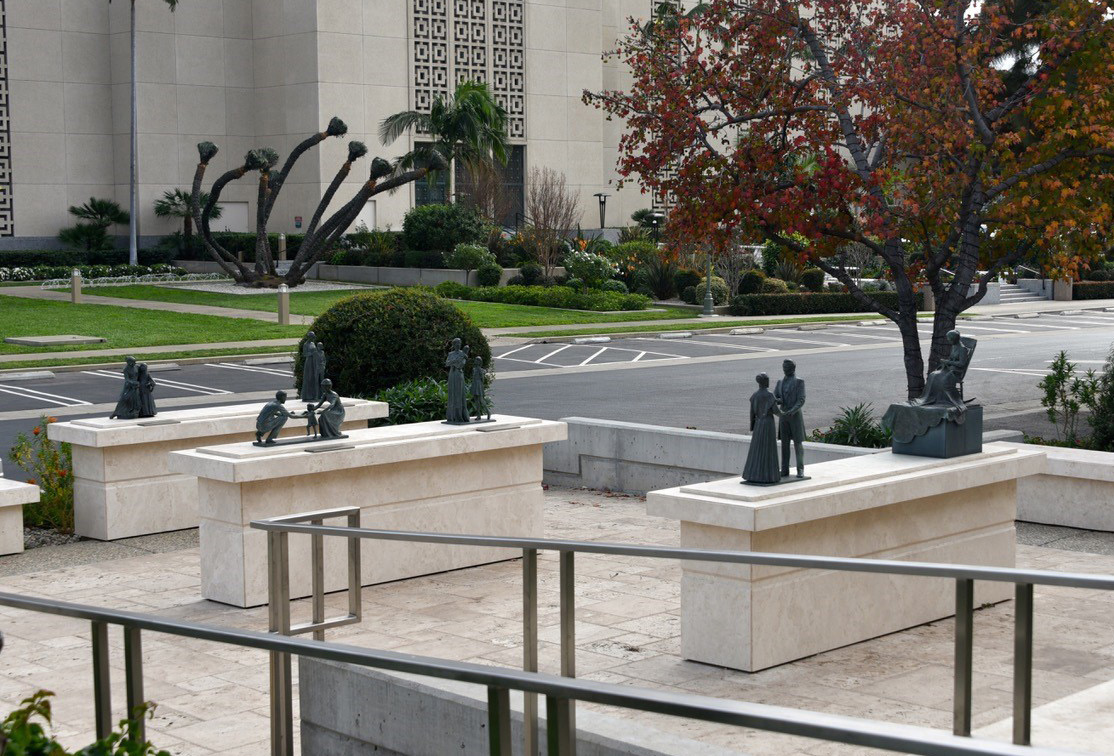
Some Challenges
Despite efforts to build positive bridges with the community, there were some difficult experiences. In 1965 the Watts riots resulted in widespread looting in various sections of Los Angeles. Racial tensions made certain areas unsafe, so some Church meetings were canceled and members were counseled to stay in their homes. In these conditions, travel to the temple became more difficult (as would happen again years later during riots following Rodney King’s death). Because the Church had not yet begun ordaining blacks to the priesthood, it specifically became a target of protest and hate. This intensified during the later 1960s when civil rights was a hot issue. Some schools refused to play Brigham Young University in athletic contests, and BYU teams were threatened or even subjected to acts of violence. There were bomb threats against Mormon buildings, including the temple. One night, Roy Kellogg, an assistant clerk in Los Angeles Stake, was on the grounds and felt impressed to walk around the temple. At the main front entrance, he found a group of people attempting to break in.[24]
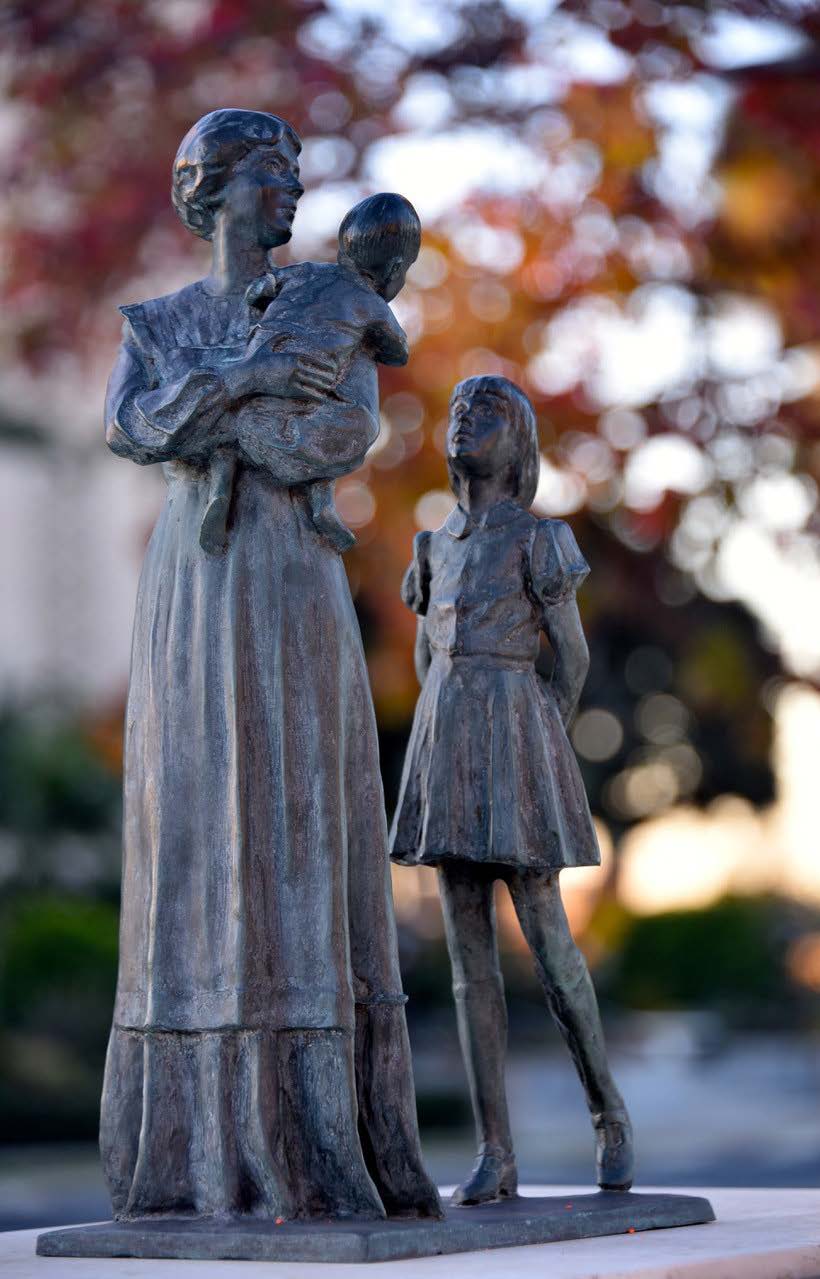
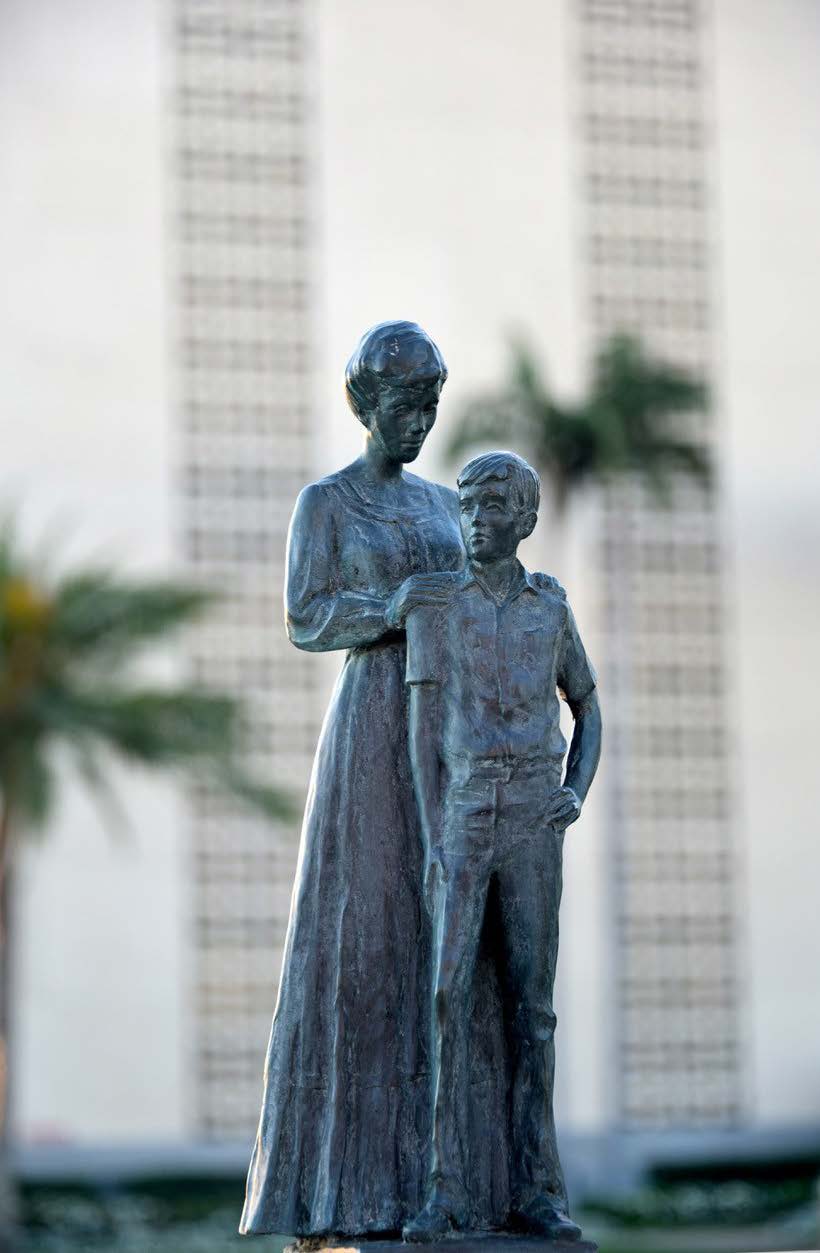
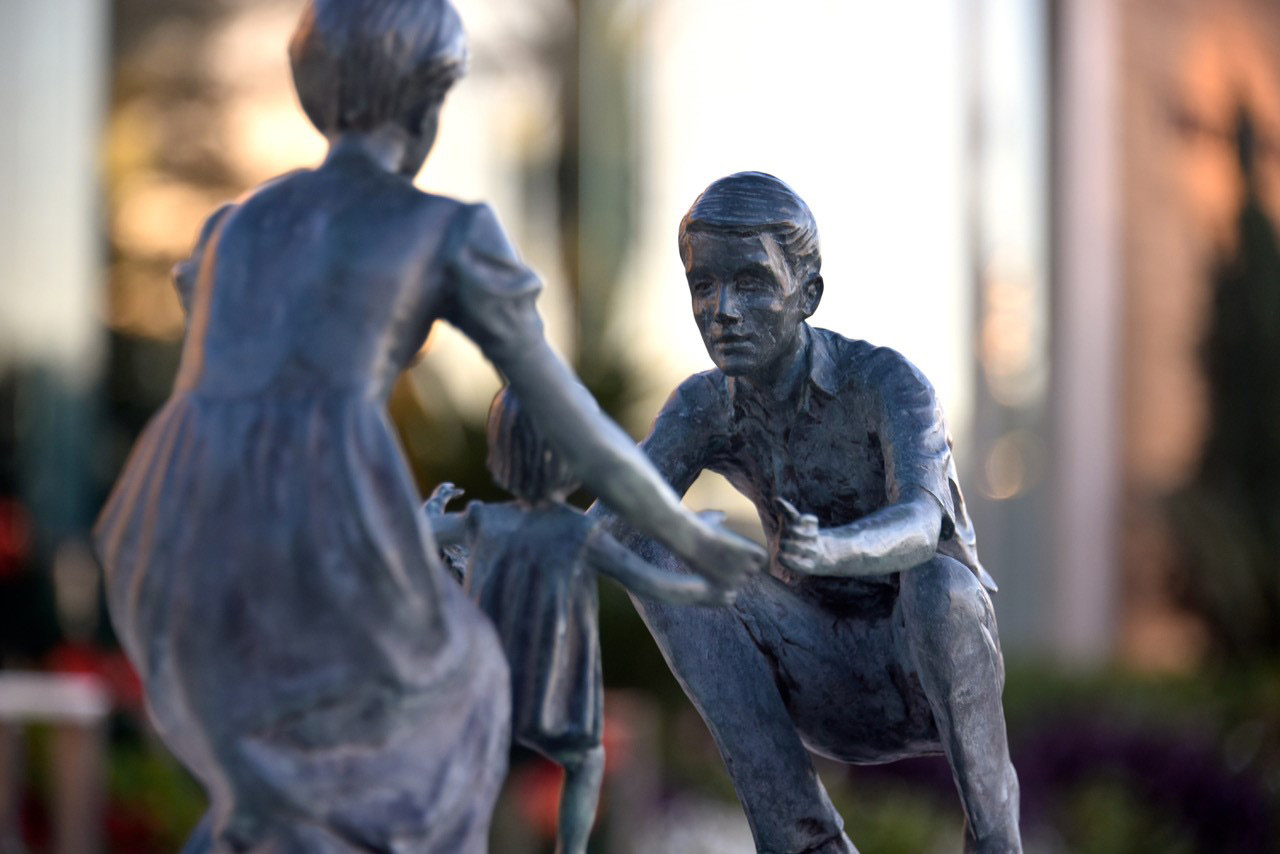
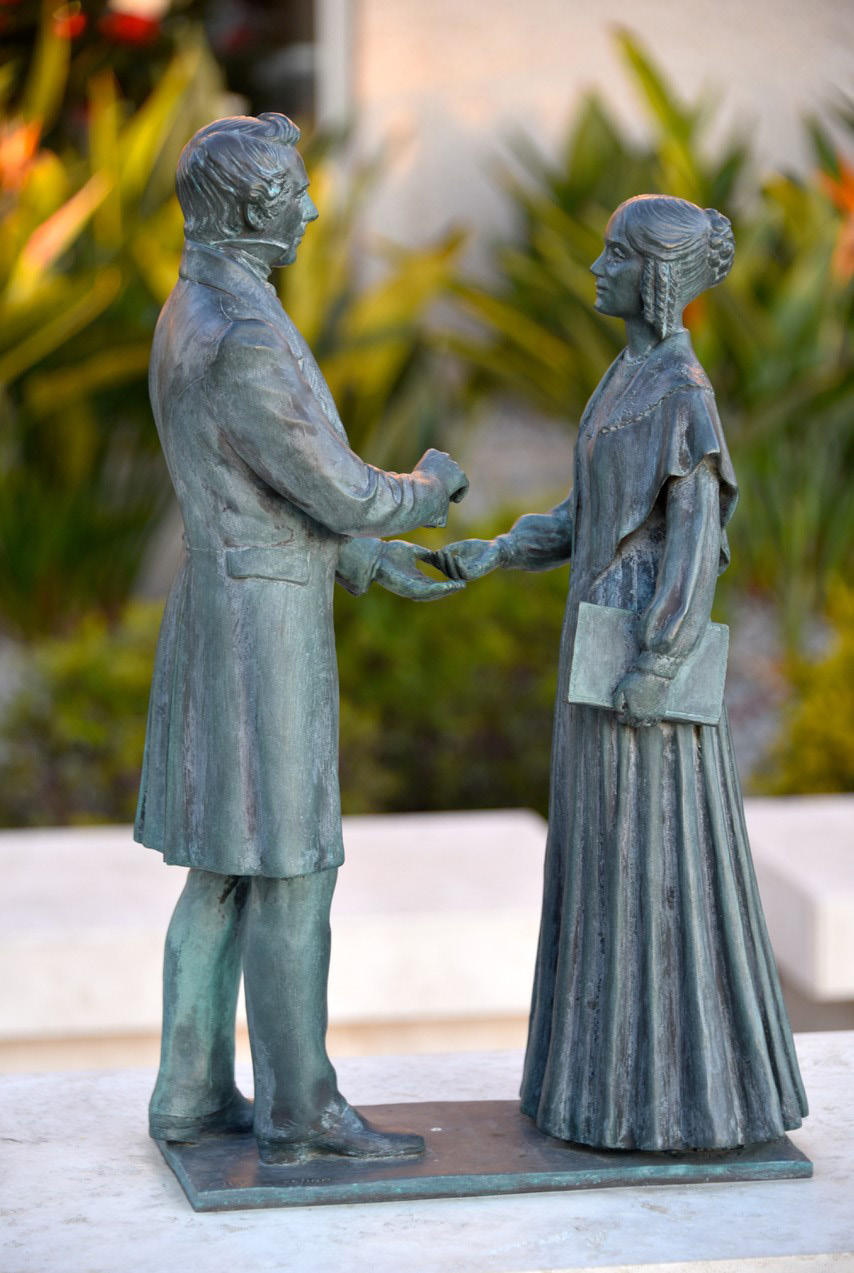
On a Sunday afternoon in 1984, a man entered the visitors’ center with a small sledge hammer concealed under his coat. He waited until the lobby was empty and all the guides were busy elsewhere. Suddenly he jumped up and began hitting the Christus statue. Quick-thinking missionaries were able to restrain him until police arrived. The visitors’ center director reported, “We got him before he got the hands, but he got all the fingers on both hands.” Fortunately, the fingers were reattached “with expert precision and the damage is not noticeable.”[25]
During the 2008 national election, The Church of Jesus Christ of Latter-day Saints rather openly urged the adoption of California’s Proposition 8, which would uphold the traditional definition of marriage as being between one man and one woman. The successful passage of this proposition sparked often violent demonstrations during the first two weeks of November. It was no surprise that the Mormon Church, including the Los Angeles Temple, became targets of these tensions. Normally the groups numbered in the dozens, but on one occasion an estimated five thousand protesters filled Santa Monica Boulevard and adjacent streets. Many were determined to damage or even destroy the temple. The police response was massive, with as many as a thousand officers being present. Many of the officers felt a personal connection to the beautiful temple they had been sent to protect, “We’re not going to let anything or anyone harm our temple!”[26] This force, coupled with the prayers of thousands of faithful Southern California Saints, protected the temple. During most of these two weeks, temple patrons were able to come and go, accomplishing their divine temple service. Only once, on Thursday afternoon, two days following the election, was it necessary to close the temple. This was done with the approval of Church leaders and at the request of the police who were concerned on that afternoon about the safety of temple workers and patrons. Those who experienced this disruption could likely empathize with the Nauvoo Saints who were forced to leave their beautiful temple. A week after the election, the temple received an envelope containing a suspicious white powder; fortunately, it proved to be nontoxic.
Around these dark clouds there was a silver lining, the Proposition-8 protests actually resulted in some goodwill toward the Church. Several ministers who had sponsored anti-Mormon events in their churches now commended the Church and its members for seeking to uphold traditional values, including the importance of marriage and the family. One person from Arizona who had opposed Proposition 8 contacted the Church and apologized for the behavior of many Proposition 8 opponents in California. He wanted to make a contribution toward the cost of cleanup following the demonstrations. Actually the only vandalism on the temple grounds was some graffiti on the fence adjacent to Santa Monica Boulevard. This was cleaned up for less than $150.
Christmas on Temple Hill
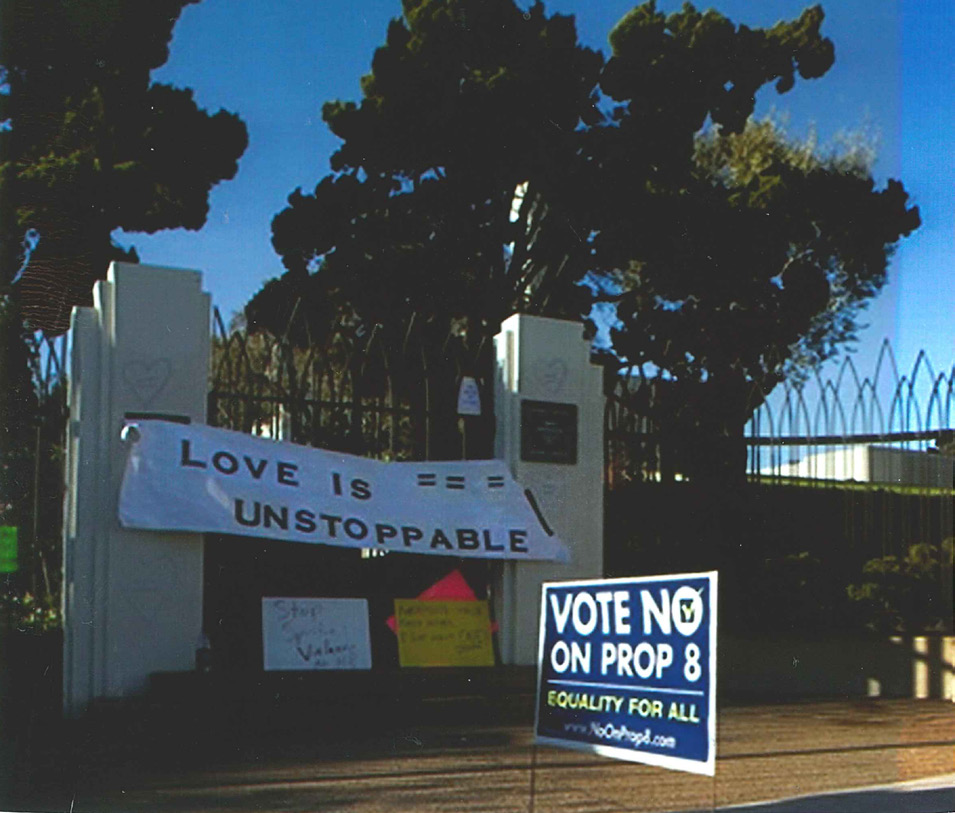
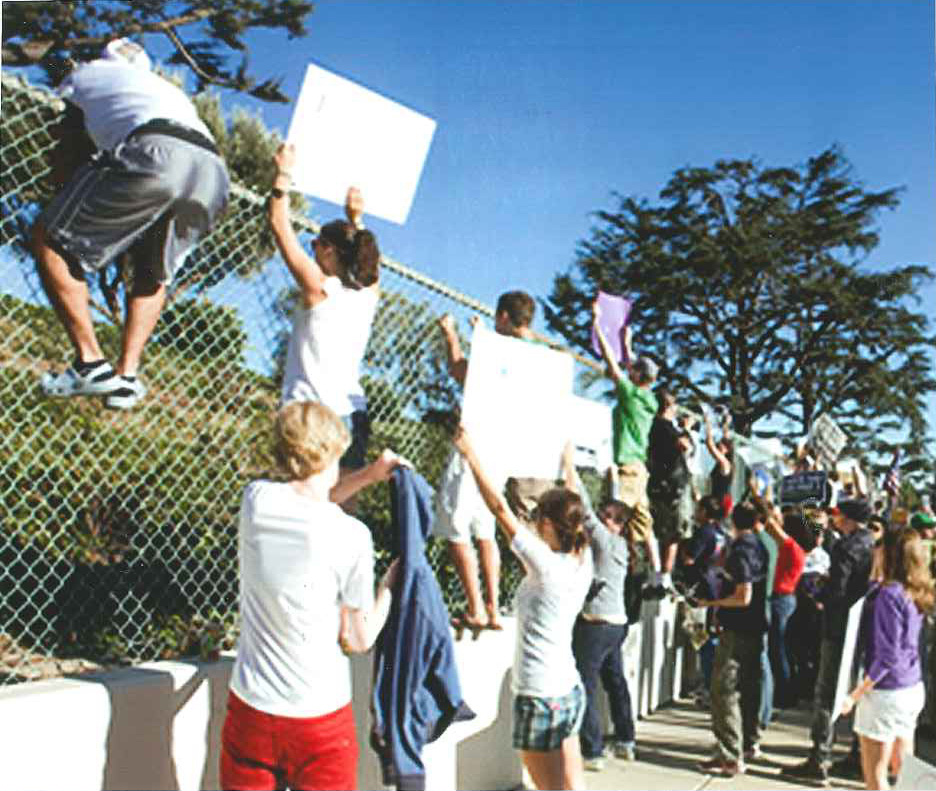

Almost from the beginning, special events at the bureau of information marked the Christmas season. In 1969, for example, a festival of choirs took place on eight evenings between December 12 and 23. Available free of charge to the public, this series featured a variety of musical groups. These included the 150-voice Mormon Choir of Southern California, three performances by a Samoan choir, the Latter-day Saint UCLA Institute student chorus, International Children’s Choir (ages 3 to 14), the Clingers, Grand Land Singers, and the Beverly Hills High School Madrigals. The noted musical Latter-day Saint King family presented a program. Soloist Rhet Robinson, television personality Heather Young, and noted singer Mavis Rivers also participated. Of the more than 40,000 who attended, 13,448 went through the visitors’ center.[27]
Lighting the grounds with Christmas lights became an annual event beginning in 1979. That year, some 30,000 white and colored bulbs adorned two Lake Shasta pines as well as evergreens on the grounds. Over the years, the number of lights continued to grow, reaching nearly a half million in the twenty-first century. Carey Stock, who designed the lighting in 1992, noted that it was a unique challenge to decorate subtropical trees with Christmas lights. One solution was to line the long trunks of palms with green lights and the fronds with red. One year, the olive trees bordering the grass slope in front of the temple were illuminated entirely in white. Another year, the façade of the visitors’ center was ablaze with “a curtain of white light.” All these lights created “an incredible traffic-stopping sight on Santa Monica Blvd.” where an estimated 60,000 people passed every day. Temple leaders hoped that at least some of them might pause and be welcomed at the visitors’ center.[28]
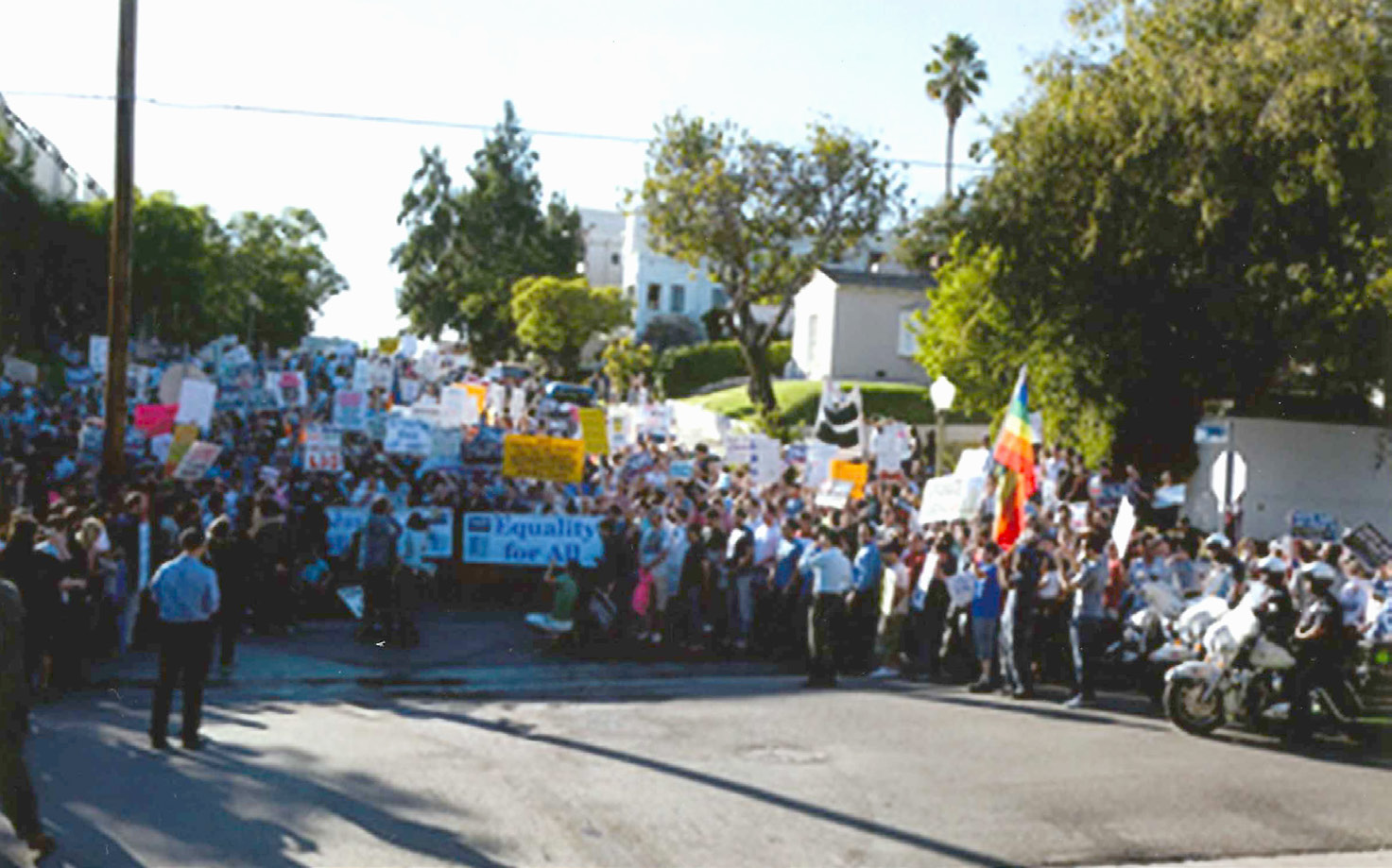
 Demonstrations following the passage of Proposition 8, which upheld the traditional definition of family. (Scrapbook)
Demonstrations following the passage of Proposition 8, which upheld the traditional definition of family. (Scrapbook)
At first the task of stringing the lights could be accomplished by the small crew composed of grounds workers and professionals from a local holiday lighting company. As the number of lights grew, however, an increasing number of volunteers were needed. In 1997 members from seventy-five stakes donated more than five thousand service hours to the project. Members helped in yet another way. When a violent windstorm destroyed the Christmas lights and decorations in 1987, stakes in the district joined forces in raising funds to replace them.[29]
The annual Christmas celebrations were extended to cover almost a full month. Lights typically were turned on immediately after Thanksgiving. Along with the impressive lighting display, the pattern of inviting community choirs, school choruses, and other groups continued. Spanish, Tongan, and other ethnic choirs enriched the diversity of the offering. Another group employed American Sign Language to present its numbers. Appropriately, singers from Emerson Junior High, located next door to the temple, also participated. Bell ringers and strolling carolers added to the ambience on the grounds.
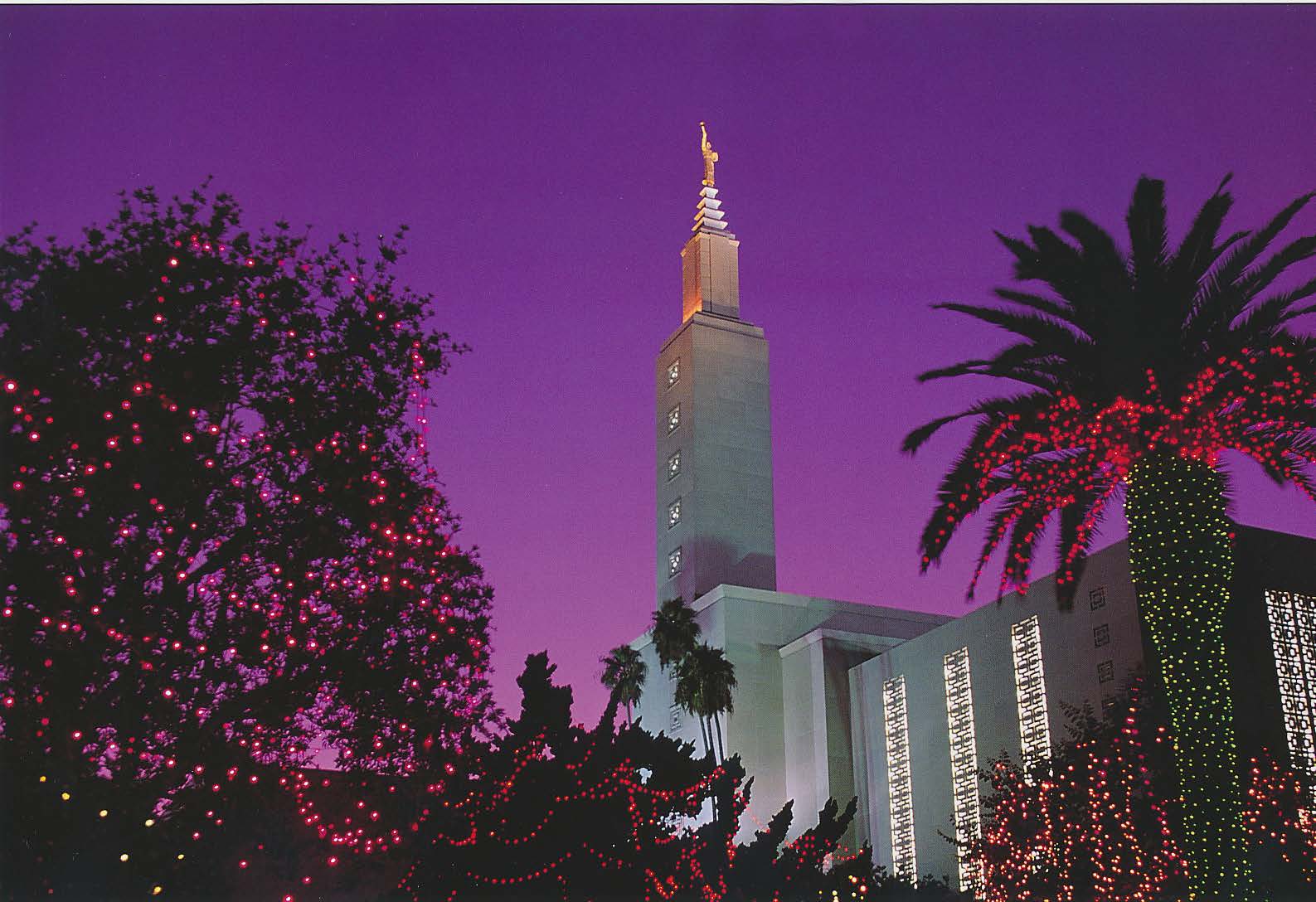
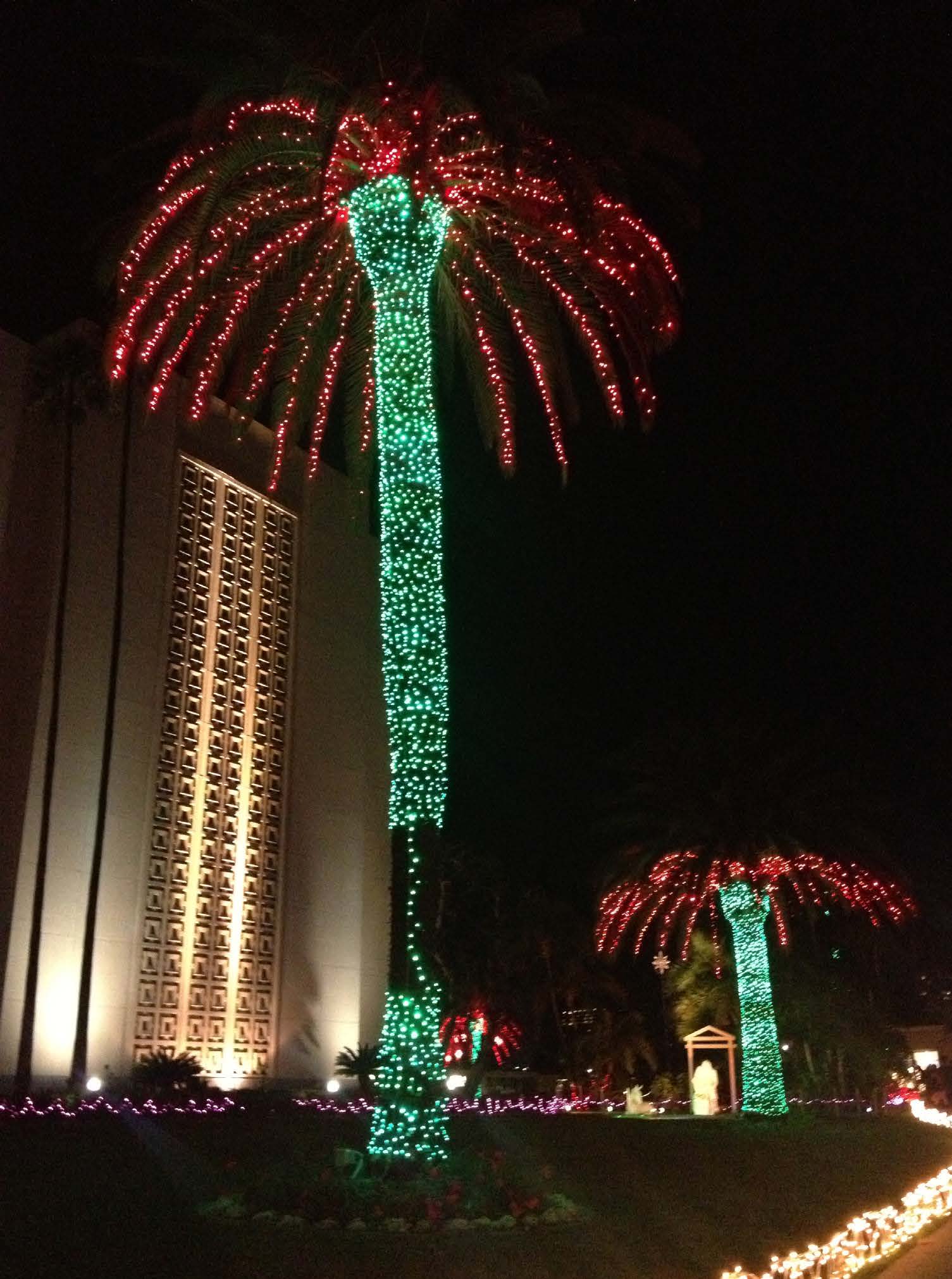
Dramatic presentations also enriched the program. In 1980, for example, there were performances of Amahl and the Night Visitors and a musical version of A Christmas Carol. A pageant, Behold the Lamb of God, featured texts drawn from the Book of Mormon and the Bible.[30] There was something different to enjoy almost every night. The visitors’ center distributed brochures listing the schedule of these free offerings and also presenting photographs and information about the temple. The object was to make as many people as possible feel welcome on the temple grounds.
Well-known Latter-day Saint television news anchors Chuck Henry and Carlos Amezcua read the Christmas story on evenings in 1998.[31] A nativity display with recorded music and scriptural narrative was set up adjacent to the visitors’ center. Those viewing the manger scene could have no doubts about Mormons truly being Christians.
The ceremony of turning on the lights for the first time each season became increasingly important. Various individuals have had the honor of flipping the switch. These have included temple and other Southern California Church leaders. Latter-day Saint political figures have also participated, including US Congressman Ron Packard and Marian Bergeson of the California State Senate. Others, not members of the Church, also have done the honors. When Los Angeles mayor Tom Bradley was invited in 1988, he recalled how as a student he had admired the beauty of the temple and its grounds as he drove by every day on his way to the UCLA law school. He also affirmed that he admired the Mormon people for “their history of conviction and dedication regardless of persecution.” The mayor declared that the Mormons have a “proud history” in the city of Los Angeles and in the state of California. He recalled several “firsts” including the Saints harvesting the first wheat in California, establishing the first newspaper in San Francisco, and being first to raise the American flag as part of a Fourth of July celebration in Los Angeles. He then quipped, “We would be a little prairie patch if the Mormons had not been here.”[32]
Each year, on the evening when the lights were turned on, the Church’s Southern California Public Affairs Council sponsored a reception at the visitors’ center to which a wide array of community leaders were invited. Guests, numbering in the thousands, included civic, business, and religious leaders. In addition to Christian pastors from several denominations, there were rabbis, imams, and sheikhs representing a variety of faiths. Diplomats from a dozen countries typically were also present. This annual Christmas gala truly was an occasion to unite the community.[33]
Thus the Los Angeles Temple impacted large groups of people, both within and outside The Church of Jesus Christ of Latter-day Saints. It also touched the lives of many individuals in interesting and unique ways.
Notes
[1] Spencer W. Kimball, “A Report of My Stewardship,” Ensign, May 1981, 5.
[2] Time, July 15, 1957, 28.
[3] “Temple Tour by Film,” Church News, March 2, 1957, 8, 15.
[4] “Temple Exhibit at Haifa,” Church News, July 6, 1957, 2.
[5] “News Notes at Home and Abroad,” Church News, November 1, 1958, 2.
[6] Benjamin L. Bowring, in Conference Report, April 1959, 38–42.
[7] “Genealogy Library Planned for L.A.,” Church News, February 1, 1964, 5; “Master Index Set for L.A. Temple Library,” Church News, February 22, 1964, 5; “Leader Dedicates L.A. Genealogy Library,” Church News, June 27, 1964, 5.
[8] Jack E. Jarrard, “A Thoughtful Quorum Project,” Church News, May 13, 1967, 14.
[9] “Japanese Class Aids Library Fund,” Church News, September 26, 1964, 13; Douglas D. Palmer, “What’s Your Line?” Church News, January 29, 1966, 14.
[10] Matthew O. Richardson, The Christus Legacy (Sandy, Utah: Leatherwood Press, 2007), 63–65.
[11] “Famed Statue at L.A. Bureau,” Church News, November 26, 1966, 5; Henry A. Smith, “A New Way to Tell Story of Mormonism,” Church News, April 29, 1967, 3.
[12] Smith, “New Way to Tell Story,” 3.
[13] Henry A. Smith, “Visitors Center in L.A. Readied,” Church News, May 6, 1967, 3, 5.
[14] Henry A. Smith, “Visitors Centers: New Missionary Tools,” Church News, July 8, 1967, 3, 10; Henry A, Smith, “Center Is Dedicated,” Church News, July 8, 1967, 8–9.
[15] “He Directs a Looking Glass,” Church News, November 27, 1971, 6.
[16] “Sculptured Family Group Readied for Los Angeles Temple Grounds,” Church News, April 26, 1958, 6.
[17] “Filming a Shot of Eternity,” Church News, February 17, 1985, 4.
[18] “Japanese Television Focuses on Latter-day Saints,” Ensign, June 1985, 799.
[19] “Miniature Sculpture at L.A. Visitors Site to Honor All Women,” Church News, August 4, 1979, 4.
[20] “Women Monument Statuettes’ Premiere Held in Los Angeles,” Church News, September 1, 1979, 7.
[21] “Miniature Schulpture,” 4.
[22] “New Garden with Statues of Women Is Dedicated at L.A. Temple,” Church News, August 30, 1980, 6.
[23] “Visitors Center Pageant Gets TV Attention,” Church News, June 27, 1981, 6.
[24] Orton, More Faith Than Fear, 241–42, 254.
[25] “L.A. Visitors Center Statue Damaged in Hammer Attack,” Church News, August 12, 1984, 6; Richardson, Christus Legacy, 65.
[26] See Los Angeles Temple scrapbook 13-9, Special Experiences.
[27] “Star-Studded Yule Program at Temple Grounds,” Church News, December 13, 1969, 10.
[28] “Lights ‘lift souls, thrill hearts,’” Church News, December 19, 1992, 6; Julie A. Dockstader, “Winter Wonderland in L.A.,” Church News, December 9, 1995, 6.
[29] “Lights of the Season,” Church News, December 20, 1997, 9; “Temple Hill Adds Beauty to Christmas,” Church News, December 3, 1988, 3; Kit Poole, “Lights Symbolize the Savior’s Birth,” Church News, December 15, 1990, 12.
[30] Church News, December 13, 1980, 3.
[31] “Grounds at L.A. Temple Ablaze in Light,” Church News, December 12, 1998, 6.
[32] Kellene Ricks, “Mayor Lauds LDS Firsts in Lighting Program,” Church News, December 3, 1988, 3.
[33] “Christmas Lights Symbolize the ‘Light of the World,’” Church News, December 21, 1996, 8; Alyssa White, “Gala Brings Community Together,” Church News, December 18, 2016, 14.